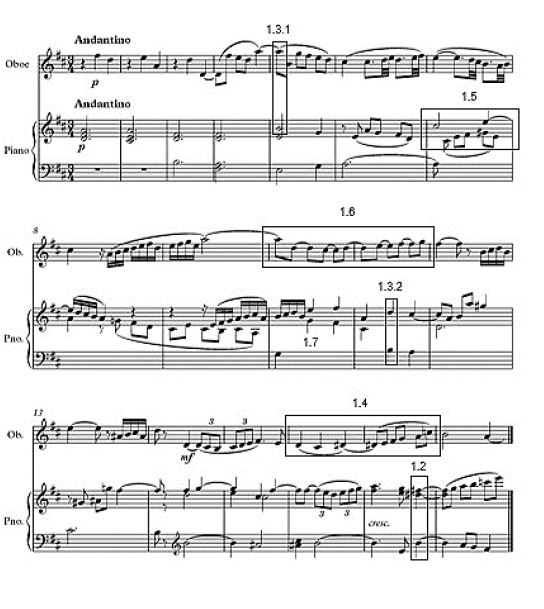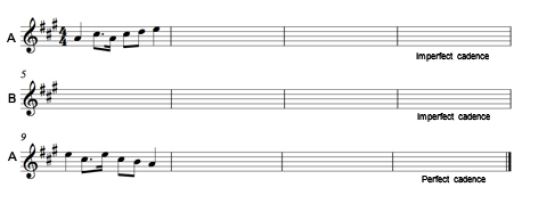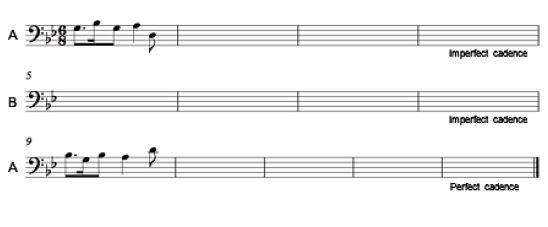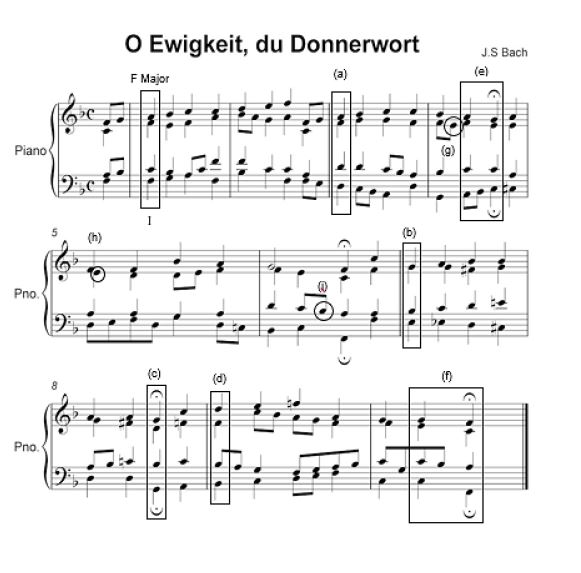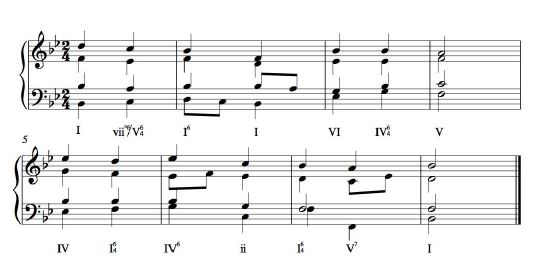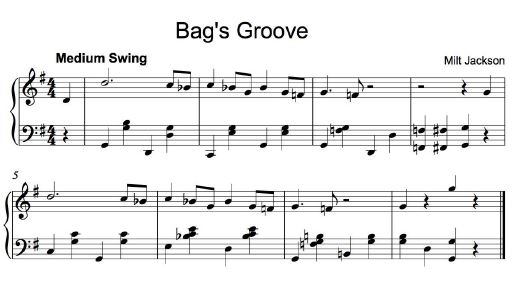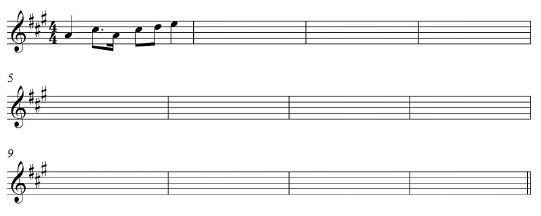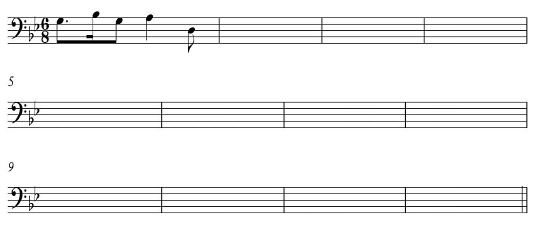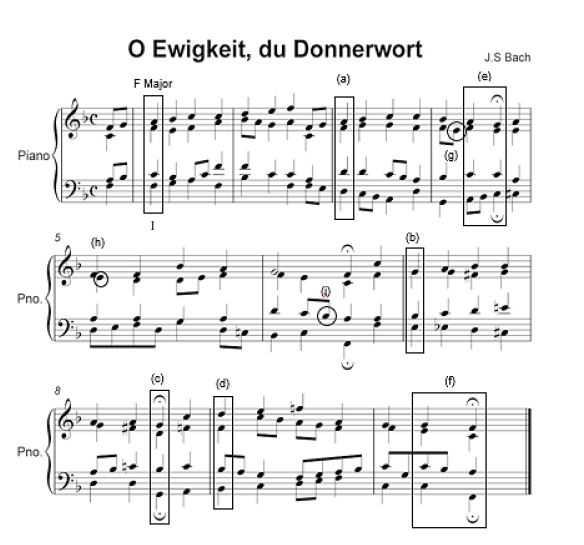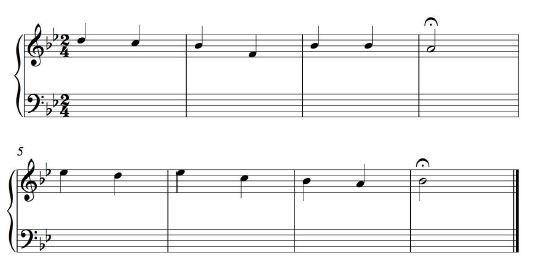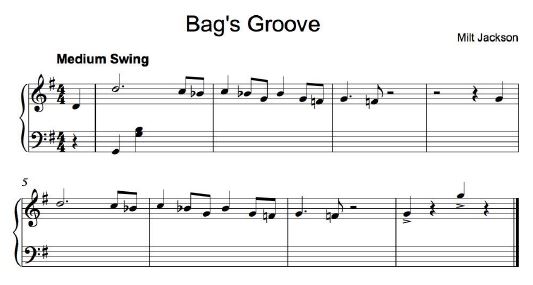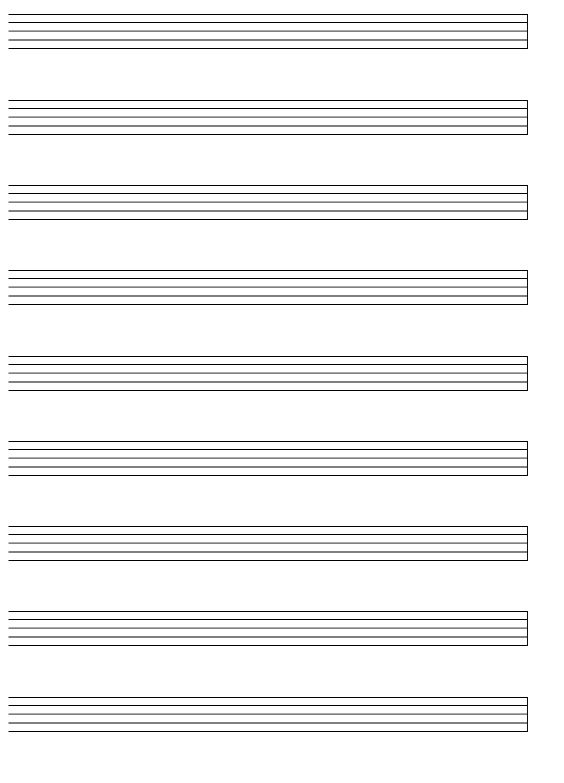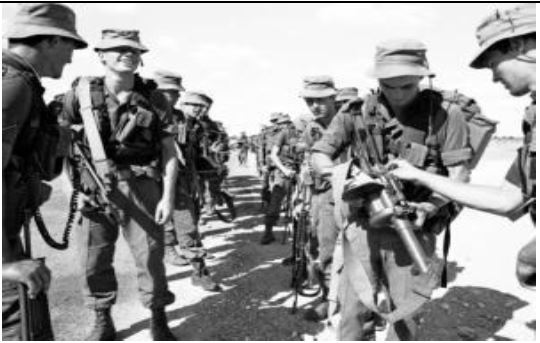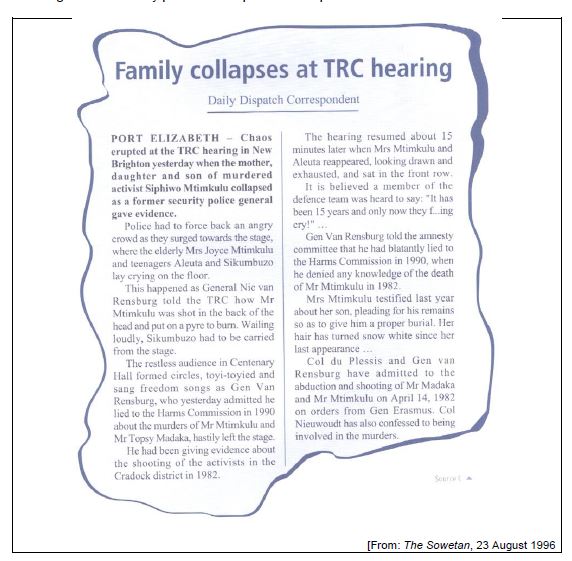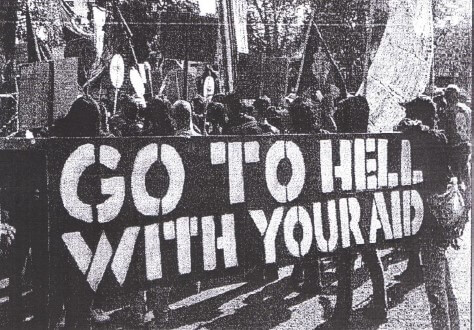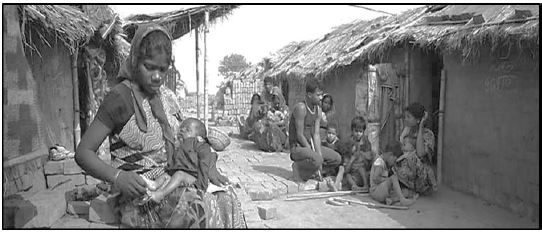Adele
INFORMATION TECHNOLOGY PAPER 1 GRADE 12 MEMORANDUM - NSC PAST PAPERS AND MEMOS SEPTEMBER 2016
INFORMATION TECHNOLOGY
PAPER ONE (P1)
GRADE 12
EXAM PAPERS AND MEMOS
SEPTEMBER 2016
MEMORANDUM
SECTION A
QUESTION 1: MARKING GRID – GENERAL PROGRAMMING SKILLS
QUESTION | DESCRIPTION | MAX MARKS | LEARNER’S MARKS |
1.1 | Button – Question 1.1 | 13 | |
1.2 | Button – Question 1.2 | 8 | |
1.3 | Button – Question 1.3 | 11 | |
| 1.4 | Button – Question 1.4 | 15 | |
| TOTAL SECTION A | 47 |
SECTION B
QUESTION 2: MARKING GRID – OBJECT-ORIENTATED PROGRAMMING
QUESTION | DESCRIPTION | MAX MARKS | LEARNER’S MARKS | |
2.1 | 2.1.1 | Type declaration | 7 | |
2.1.2 | Constructor | 3 | ||
2.1.3 | APS | 4 | ||
2.1.4 | Bachpass | 8 | ||
2.1.5 | Compilestring | 3 | ||
| 2.2 | Get name ✔ | 17 | ||
| TOTAL SECTION B | 42 | |||
SECTION C
QUESTION 3: MARKING GRID – PROBLEM-SOLVING PROGRAMMING
QUESTION | DESCRIPTION | MAX MARKS | LEARNER’S MARKS |
Program techniques | Dynamic Component ✔✔
Programming Techniques
| 5 | |
Get Information , Sort and Display | Get information from Text File – examnumbers.txt | 18 | |
| Search | Initialise variables ✔ | 15 | |
| Add | Get centre and exam number to be added ✔ Increase the counter ✔ | 10 | |
| Delete | Rewrite the ‘examnumber.txt’ file ✔ | 13 | |
| TOTAL SECTION C | 61 | ||
| GRAND TOTAL | 150 |
NAME OF LEARNER: _________________________ GRADE 12: ________ SUMMARY OF LEARNER’S MARKS:
SECTION A | SECTION B | SECTION C | ||
QUESTION 1 | QUESTION 2 | QUESTION 3 | GRAND TOTAL | |
MAX MARKS | 47 | 42 | 61 | 150 |
LEARNER’S MARKS |
QUESTION 1 – SAMPLE SOLUTION
unit Question1_u;
interface
uses
Windows, Messages, SysUtils, Variants, Classes, Graphics, Controls, Forms, Dialogs, StdCtrls, ComCtrls, ExtCtrls, Spin;
type
TForm1 = class(TForm)
Panel1: TPanel;
Edit1: TEdit;
RadioGroup1: TRadioGroup;
ComboBox1: TComboBox;
ComboBox2: TComboBox;
RichEdit1: TRichEdit;
Button1: TButton;
Label1: TLabel;
Panel2: TPanel;
Panel3: TPanel;
Edit2: TEdit;
Edit3: TEdit;
Label2: TLabel;
Label3: TLabel;
Button2: TButton;
Button3: TButton;
Panel4: TPanel;
Button4: TButton;
ComboBox3: TComboBox;
ComboBox4: TComboBox;
ComboBox5: TComboBox;
ComboBox6: TComboBox;
Edit4: TEdit;
Edit5: TEdit;
Edit6: TEdit;
Edit7: TEdit;
SpinEdit1: TSpinEdit;
SpinEdit2: TSpinEdit;
SpinEdit4: TSpinEdit;
SpinEdit5: TSpinEdit;
SpinEdit6: TSpinEdit;
SpinEdit7: TSpinEdit;
Panel5: TPanel;
SpinEdit3: TSpinEdit;
Panel6: TPanel;
procedure Button1Click(Sender: TObject);
procedure Button2Click(Sender: TObject);
procedure Button4Click(Sender: TObject);
procedure Button3Click(Sender: TObject);
private
{ Private declarations }
public
{ Public declarations }
end;
var
Form1: TForm1;
ichange : integer;
slearner : string;
implementation
{$R *.dfm}
procedure TForm1.Button1Click(Sender: TObject);
var
sinitial, ssurname, ssubjectto, ssubjectfrom, sgrade : string;
ipos : integer;
begin
slearner := edit1.text;
sinitial := slearner[1];
ipos := pos(' ',slearner);
ssurname := copy(slearner,ipos + 1,length(slearner)-ipos);
sgrade := radiogroup1.items[radiogroup1.itemindex];
ssubjectfrom := combobox1.text;
ssubjectto := combobox2.text;
if ssubjectfrom = ssubjectto then
richedit1.Lines.add('Incorrect information')
else
if (combobox1.ItemIndex = -1) and (combobox2.ItemIndex = -1) then richedit1.lines.add('Learner: '+sinitial + ' '+ssurname+#13+'Grade: '+sgrade+#13+'NO SUBJECT CHANGE')
else
begin
richedit1.lines.add('Learner: '+sinitial + ' '+ssurname+#13+'Grade: '+sgrade+#13+'Subject Change from '+ ssubjectfrom+ ' to '+ ssubjectto); Showmessage('Please submit all the required documents');
end;
end;
procedure TForm1.Button2Click(Sender: TObject);
var
sdob, sid : string;
begin
sdob := edit2.text;
sid := edit3.text;
if (copy(sdob,3,2) = copy(sid,1,2)) and (copy(sdob,6,2) = copy(sid,3,2)) and (copy(sdob,9,2) = copy(sid,5,2)) then
Showmessage('Correct')
else
Showmessage('Do not match');
end;
procedure TForm1.Button4Click(Sender: TObject); var
arrsubjects : array[1..7] of integer;
iabove40, iabove30, ibelow30, k : integer;
begin
iabove40 := 0;
ibelow30 := 0;
iabove30 := 0;
arrsubjects[1] := spinedit1.value;
arrsubjects[2] := spinedit2.value;
arrsubjects[3] := spinedit3.value;
arrsubjects[4] := spinedit4.value;
arrsubjects[5] := spinedit5.value;
arrsubjects[6] := spinedit6.value;
arrsubjects[7] := spinedit7.value;
if arrsubjects[1] < 40 then
panel5.Caption := 'FAIL';
for k := 1 to 7 do
begin
if arrsubjects[k] >= 40 then
begin
inc(iabove40);
end
else
if (arrsubjects[k] >= 30) and (arrsubjects[k] < 40) then
begin ]
inc(iabove30);
end
else
if (arrsubjects[k] < 30) then
inc(ibelow30);
end;
if (arrsubjects[1] < 40) or (iabove40 < 3) or (ibelow30 >=2 ) then panel5.Caption := 'FAIL'
else
panel5.caption := 'PASS';
end;
procedure TForm1.Button3Click(Sender: TObject); var
ilen, k, iran : integer;
susername : string;
begin
randomize;
ilen := length(slearner);
ShowMessage(inttostr(ilen));
susername := '';
k := 0;
while (k < ilen) do
begin
inc(k);
if not (upcase(slearner[k]) in ['A','E','I','O','U',' ']) then susername := susername + slearner[k]; end;
showmessage(susername);
iran := random(301)+100;
panel6.Caption := susername + '%' + inttostr(iran) + '#'; end;
end.
QUESTION 2 – SAMPLE SOLUTION
unit clsLearners;
interface
uses sysutils;
type
TArrmarks = array[1..7] of integer;
TLearner = class
private
fname : string;
fapspoints : integer;
fbachpass : boolean;
fsubject : integer;
public
constructor create(sname: string; isubject:integer); procedure APS(arrmarks : Tarrmarks);
function bachpass(arrmarks : Tarrmarks):boolean; function tostring : string;
end;
implementation
{ TLearner }
procedure TLearner.APS(arrmarks: Tarrmarks);
var
k, ilevel : integer;
begin
for k := 1 to 7 do
begin
case arrmarks[k] of
80..100 : ilevel := 7;
70..79 : ilevel := 6;
60..69 : ilevel := 5;
50..59 : ilevel := 4;
40..49 : ilevel := 3;
30..39 : ilevel := 2;
0..29 : ilevel := 1;
end;
fapspoints := fapspoints + ilevel;
end;
end;
function TLearner.bachpass(arrmarks : Tarrmarks): boolean;
var
ibach, k : integer;
begin
ibach := 0;
for k := 1 to fsubject do
begin
if arrmarks[k] >=50 then
inc(ibach);
end;
if ibach >= 4 then
result := true
else
result := false;
end;
constructor TLearner.create(sname: string; isubject:integer);
begin
fname := sname;
fsubject := isubject;
fapspoints := 0;
end;
function TLearner.tostring: string;
begin
result := 'Learner Name: '+ fname + #13+ 'Bachelor Pass: Yes'+#13+'APS points: '+inttostr(fapspoints);
end;
end.
unit Question2_u;
interface
uses
Windows, Messages, SysUtils, Variants, Classes, Graphics, Controls, Forms, Dialogs, clsLearners, StdCtrls;
type
TForm1 = class(TForm)
Edit1: TEdit;
Button1: TButton;
Label1: TLabel;
procedure Button1Click(Sender: TObject);
private
{ Private declarations }
public
{ Public declarations }
end;
var
Form1: TForm1;
Learner : TLearner;
arrmarks : Tarrmarks;
implementation
{$R *.dfm}
procedure TForm1.Button1Click(Sender: TObject);
var
sname : string;
k, isubject : integer;
begin
sname := edit1.text;
isubject := Strtoint(inputbox('How many subjects are you registered for?','','')); if isubject < 7 then
begin
repeat
Showmessage('Minimum of 7 subjects are required');
isubject := Strtoint(inputbox('How many subjects are you registered for?','','')); until (isubject >=7);
end;
learner := TLearner.create(sname, isubject);
for k := 1 to isubject do
begin
arrmarks[k] := strtoint(inputbox('Enter Marks','Subject '+inttostr(k),''));
end;
if learner.bachpass(arrmarks) = true then
begin
learner.aps(arrmarks);
Showmessage(learner.tostring);
end
else
Showmessage('You did not meet the Bachelor Pass requirements');
end;
end.
QUESTION 3 – SAMPLE SOLUTION
unit Question3_u;
interface
uses
Windows, Messages, SysUtils, Variants, Classes, Graphics, Controls, Forms, Dialogs, StdCtrls, ComCtrls;
type
TForm1 = class(TForm)
Button1: TButton;
RichEdit1: TRichEdit;
Button2: TButton;
Button3: TButton;
Edit1: TEdit;
Edit2: TEdit;
Button4: TButton;
Label1: TLabel;
Label2: TLabel;
procedure FormCreate(Sender: TObject);
procedure Button1Click(Sender: TObject);
procedure Button2Click(Sender: TObject);
procedure Button3Click(Sender: TObject);
procedure Button4Click(Sender: TObject);
private
{ Private declarations }
public
procedure Sort;
end;
var
Form1: TForm1;
icount : integer;
arrexamnumbers : array[1..250] of string;
arrcentres : array[1..2] of string = ('4181078,Stirling High School', '4181009,Clarendon High School for Girls');
implementation
{$R *.dfm}
procedure TForm1.FormCreate(Sender: TObject);
var
myfile : textfile;
soneline : string;
begin
if fileexists('examnumbers.txt') = true then
begin
Assignfile(myfile, 'examnumbers.txt');
Reset(myfile);
icount := 0;
while not eof(myfile) do
begin
readln(myfile,soneline);
inc(icount);
arrexamnumbers[icount] := soneline;
end;
Sort;
Closefile(myfile);
end
else
Showmessage('File does not exist');
end;
procedure TForm1.Sort;
var
k, l : integer;
stemp : string;
begin
for k := 1 to icount-1 do
for l := k + 1 to icount do
begin
if arrexamnumbers[k] > arrexamnumbers[l] then
begin
stemp := arrexamnumbers[k];
arrexamnumbers[k] := arrexamnumbers[l]; arrexamnumbers[l] := stemp;
end;
end;
end;
procedure TForm1.Button1Click(Sender: TObject);
var
k : integer;
begin
for k := 1 to icount do
richedit1.lines.add(arrexamnumbers[k]);
end;
procedure TForm1.Button2Click(Sender: TObject);
var
k,j, ipos, ilen, inum : integer;
ssearch,sschoolname,scentre : string;
bfound : boolean;
begin
richedit1.Lines.clear;
k := 0;
j := 1;
inum := 0;
ssearch := inputbox('','','');
bfound := false;
while (j <= 2) and (bfound = false) do
begin
if copy(arrcentres[j],4,4) = copy(ssearch,4,4) then
begin
bfound := true;
ipos := pos(',',arrcentres[j]);
ilen := length(arrcentres[j]);
sschoolname := copy(arrcentres[j],ipos+1,ilen-ipos);
end;
inc(j);
end;
if bfound = true then
begin
richedit1.lines.add(sschoolname + #13);
while (k <= icount) do
begin
inc(k);
scentre := copy(arrexamnumbers[k],6,4);
if scentre = copy(ssearch,4,4) then
begin
inc(inum);
richedit1.lines.add(arrexamnumbers[k]);
end;
end;
richedit1.lines.add('Total Learners: ' + inttostr(inum));
end
else
richedit1.lines.add('Centre not found');
end;
procedure TForm1.Button3Click(Sender: TObject);
var
myfile : textfile;
scentre, sexamnumber : string;
k : integer;
begin
Assignfile(myfile, 'examnumbers.txt');
Append(myfile);
scentre := edit1.text;
sexamnumber := edit2.text;
inc(icount);
arrexamnumbers[icount] := sexamnumber;
writeln(myfile, sexamnumber);
Closefile(myfile);
Showmessage('New learner '+ sexamnumber+' - successfully added');
Sort;
richedit1.clear;
for k := 1 to icount do
richedit1.lines.add(arrexamnumbers[k]);
end;
procedure TForm1.Button4Click(Sender: TObject);
var
myfile : textfile;
sdelete : string;
k, idelete : integer;
begin
Assignfile(myfile, 'examnumbers.txt'); Rewrite(myfile);
sdelete := inputbox('','','');
for k := 1 to icount do
begin
if arrexamnumbers[k] = sdelete then idelete := k;
end;
for k := idelete to icount - 1 do
arrexamnumbers[k] := arrexamnumbers[k+1];
dec(icount);
arrexamnumbers[icount] := '';
Showmessage('Learner deleted');
Sort;
for k := 1 to icount do
begin
writeln(myfile,arrexamnumbers[k]);
richedit1.Lines.add(arrexamnumbers[k]);
end;
Closefile(myfile);
end;
end.
INFORMATION TECHNOLOGY PAPER 1 GRADE 12 QUESTIONS - NSC PAST PAPERS AND MEMOS SEPTEMBER 2016
INFORMATION TECHNOLOGY
PAPER ONE (P1)
GRADE 12
EXAM PAPERS AND MEMOS
SEPTEMBER 2016
INSTRUCTIONS AND INFORMATION
- This question paper is divided into THREE sections. Learners must answer ALL THREE sections.
- The duration of this examination is THREE hours. Because of the nature of this examination it is important to note that you will not be permitted to leave the examination room before the end of the examination session.
- Make sure that you answer the questions in accordance to the specifications that are given in each question. Marks will be awarded according to the set requirements.
- Answer only what is asked in each question. For example, if the question does not ask for data validation, then no marks will be awarded for data validation.
- Your programs must be coded in such a way that they will work with any data and not just the sample data supplied or any data extracts that appear in the question paper.
- Routines such as search, sort and selection must be developed from first principles. You may NOT use the built-in features of a programming language for any of these routines.
- You must save your work regularly.
- The files that you need to complete this question paper have been given to you on a disk/network. The files are given in the form of password-protected executable files:
Do the following:
- Double click on the password-protected executable file.
- Click on the extract button.
- Enter the following password: School%4*#
QUESTION 1
Question1_p.dpr
Question1_u.pas
Question1_u.dfm
QUESTION 2
clsLearners.pas
Question2_p.dpr
Question2_u.pas
Question2_u.dfm
QUESTION 3
examnumbers.txt
Question3_p.dpr
Question3_u.pas
Question3_u.dfm
QUESTIONS
SECTION A
QUESTION 1: GENERAL PROGRAMMING SKILLS
| All Grade Twelve learners have to check their examination entry for the National Exam at the end of each year. Subject changes are allowed, but all supporting documents must be submitted. All information that is entered, must be correct. |
INSTRUCTIONS:
|
1.1 Question 1.1 Button
The learner must enter his/her name and surname in the given text area. The relevant grade must be selected. The old and new subject must also be selected. If the old and new subject is the same, display an ‘Incorrect Information’ message. If no subject change is made, display the learner’s details and ‘No subject change’. If a subject change has been made, display the learner’s information as well as a message indicating that all required documents should be submitted.
Example of output:
INCORRECT INFORMATION: NO SUBJECT CHANGE: 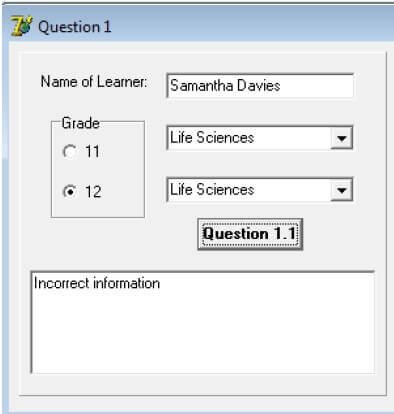
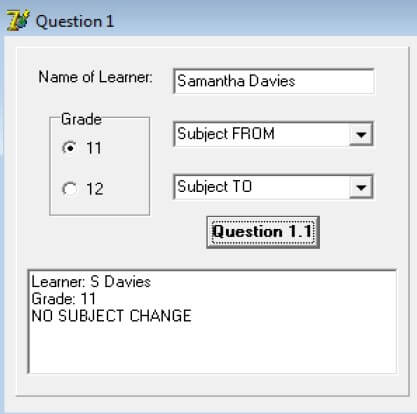
SUBJECT CHANGE: 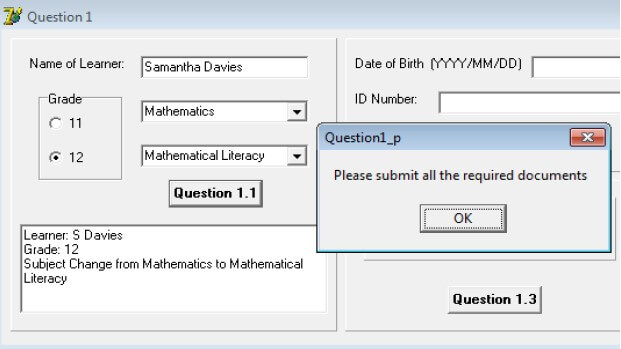 (13)
(13)
Question 1.2 Button
The ID number must be validated by comparing it with the date of birth. Display a suitable message to indicate whether it is correct or incorrect.
Example of output: (8)
1.3 Question 1.3 Button
A username needs to be created. It is generated by removing all the vowels and spaces from the candidate’s name and surname (as entered in Question 1.1); ‘%’; a random number between 100 and 300 (inclusive) and ‘#’.
Example of output (Take note: The output will be different due to random numbers): (11)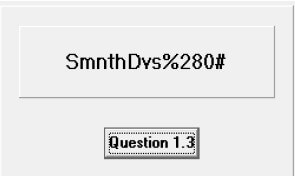
1.4 Question 1.4 Button
Code must be written to calculate whether the candidate has achieved a pass based on the marks they have entered.
Requirements for a pass are as follows:
- Home Language must be 40% or more
- 40% in three other subjects
- 30% in two subjects
Display on the panel whether the candidate has passed or failed.
Example of output: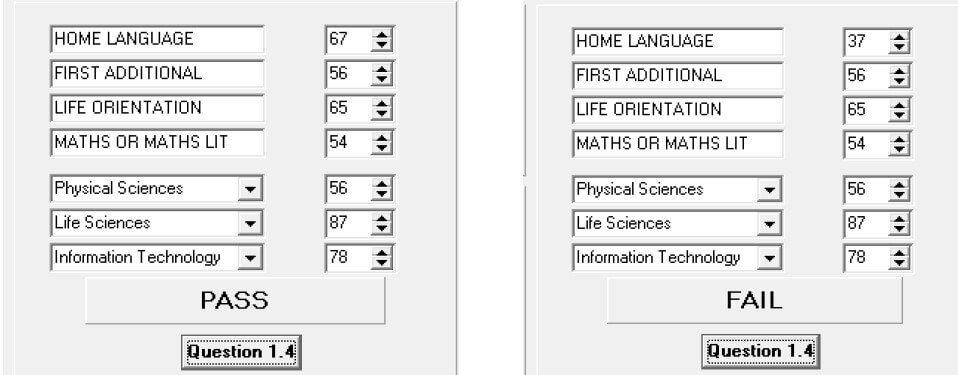
1.5 (15) 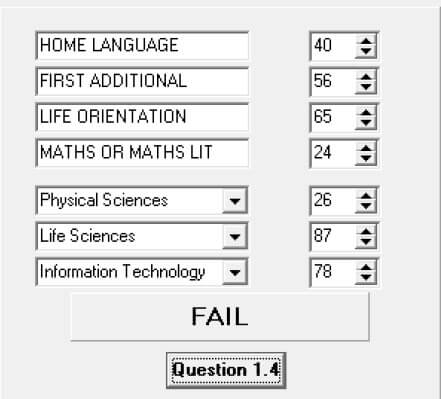
|
TOTAL SECTION A: 47
SECTION B
QUESTION 2: OBJECT-ORIENTED PROGRAMMING
| To get admission to tertiary institutions one must achieve a certain amount of Admission Points depending on the course and institution. |
INSTRUCTIONS:
|
2.1
2.1.1 Declare an array with class scope which will store the candidate’s marks (maximum 10 subjects). The private attributes are given; declare the public methods as you answer the questions below. (7)
2.1.2 Write code for the constructor method which will receive and assign the candidate’s name and number of subjects. The attribute fapspoints must be initialised. (3)
2.1.3 Write a method called APS which will receive the marks from the array, convert it to the respective level and then calculate the APS points. APS points are calculated by converting the percentages to the respective levels and adding the levels together.
Percentage Level
80-100 7
70-79 6
60-69 5
50-59 4
40-49 3
30-39 2
0-29 1 (4)
2.1.4 Write a method called BachPass which will receive the marks and return whether the learner has achieved a bachelor’s pass.
In order to qualify for a bachelor pass, the learner must achieve at least 50% in four subjects. Assume that all the subjects are from the designated list of subjects. (8)
2.1.5 Write a method called CompileString which will return the information as shown in the following format:
Learner’s Name: <fname>
Bachelor Pass: <Yes/No>
APS Points: <fapspoints> (3)
2.2 The learner’s name must be entered in the text area; then the number of subjects that the learner is enrolled for must be entered using an InputBox component.
If the learner entered less than 7 subjects, then the learner must enter the number of subjects again until it is 7 subjects or more.
The learner must enter the marks and these marks must be stored in an array. Once the marks are entered, then the program must check whether the learner qualifies for a bachelor pass. If the learner has a bachelor pass, then APS must be calculated. All the information must be displayed as shown in the example below. All relevant methods must be called.
If the learner does not qualify for a bachelor pass, a suitable message must be displayed. (17)
Example of output: 
|
TOTAL SECTION B: 42
SECTION C
QUESTION 3: PROBLEM SOLVING PROGRAMMING
| A record of all the exam numbers and centres must be kept accurately for statistical purposes. Sometimes new candidates are added and some are deregistered for various reasons. It is also important to know how many candidates each centre has. |
INSTRUCTIONS:
|
You are required to design a program that must be able to do the following:
- Get the exam numbers from a text file named examnumbers.txt
- Sort and display the exam numbers
- Search for a specific centre
- Add a new exam number to the array and text file
- Delete an exam number
Read the following sections before attempting the solution:
- GUI and data supplied
- Program requirements
- Mark allocation
NOTE:
- You may NOT modify data supplied.
- The use of good programming techniques and modular design must be applied in the design and coding of your solution.
GUI AND DATA SUPPLIED
GUI
The GUI contains components for input and output. Additional components will be required. At least one dynamic component must be used.
Example of GUI provided: 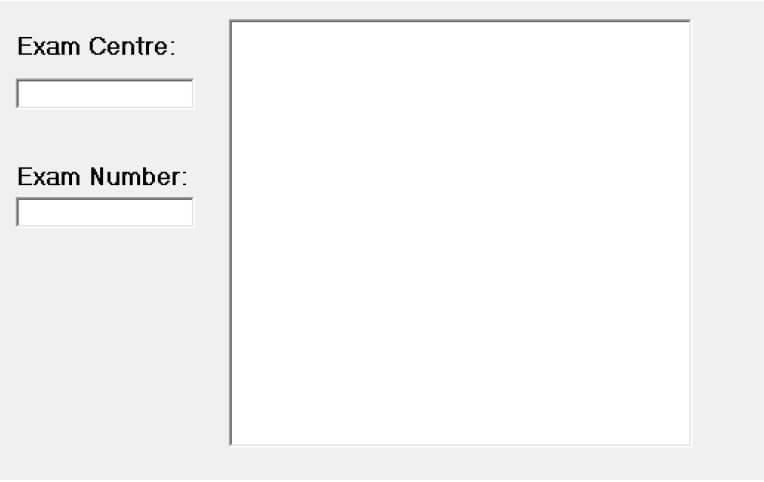
DATA
The exam centre number forms part of the candidate’s exam number. If the candidate’s exam number is 4151610060031, then it can be interpreted as follows:
- The last four numbers (0031) represents the candidate’s number at the centre
- The centre number consists of the numbers following the positions: 1; 4 – 9 (4161006)
- The second and third number (15) can be ignored in this question.
The exam centres are stored in a one-dimensional array called arrcentres.
The examnumbers of the candidates are stored in a textfile named examnumbers.txt.
PROGRAM REQUIREMENTS
Get Information, Sort and Display
- Get the contents of the examnumbers.txt text file.
- Sort it in ascending order.
- Display the sorted exam numbers.
Search for centre number
- The user must enter a centre number.
- If the centre number is found, the school name as well as all the exam numbers from that particular centre must be displayed.
- The total number of candidates must be displayed as well.
- If the centre number is not found, a suitable message must be displayed.
Add exam centre and exam number
- Get the information that must be added from the user
- Add the exam number to the array as well as to the text file
- Display a message that the exam number has been added to the text file ∙ Sort and display the updated array
Delete an exam number
Sometimes candidates are deregistered due to various reasons.
- Ask the user to enter the exam number to be removed
- Delete the exam number from the text file as well as from the array
- Display a message once the exam number is deleted
- Sort and display the updated array
- Write the updated array to the existing text file
MARK ALLOCATION
REQUIREMENTS | MAXIMUM MARKS |
Modular Design, Dynamic Component, Indentation | 5 |
Get Information, Sort and Display | 18 |
Search | 15 |
Add | 10 |
Delete | 13 |
|
TOTAL SECTION C: 61
GRAND TOTAL: 150
MUSIC PAPER 2 GRADE 12 MEMORANDUM - NSC PAST PAPERS AND MEMOS SEPTEMBER 2016
MUSIC
PAPER TWO (P2)
GRADE 12
EXAM PAPERS AND MEMOS
SEPTEMBER 2016
MEMORANDUM
SECTION A: AURAL
QUESTION 1 (COMPULSORY)
| Play Track 1 THREE times. Pause for 30 seconds in between. |
1.1 Listen to the melodic and rhythmic phrase. Notate the rhythm of the missing notes in bars 2–3 below. 
| Play Track 1 ONCE more. |
| Play Track 2 TWICE in succession. |
1.2 Make a cross (X) in the block next to the correct time signature of this extract.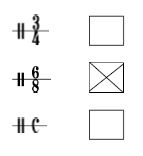
[4]
QUESTION 2 (COMPULSORY)
| Play Track 3 ONCE to provide a general overview. |
Listen to the extract from the second movement of Cello Concerto, Op. 104 by A. Dvořák. Answer the questions that follow. 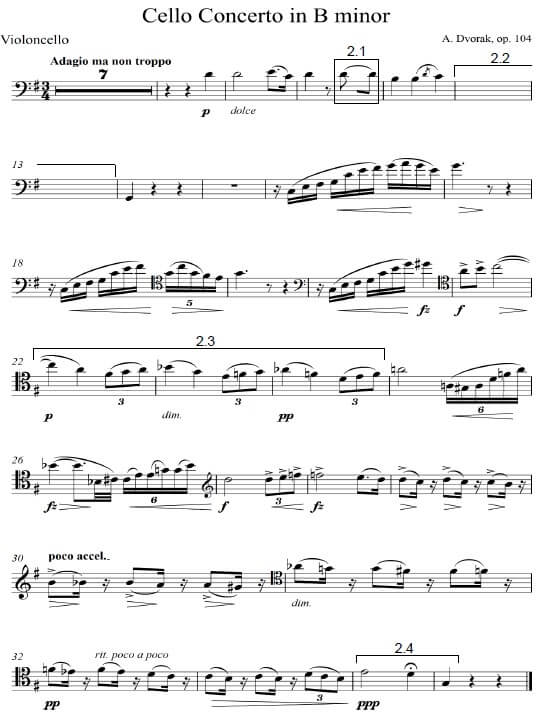
| Play Track 4 TWICE. |
2.1 Name the interval at 2.1, for example Major 3rd.
Answer: Perfect 4th (1)
| Play Track 4 FOUR times. Pause ONE minute between each repetition. |
2.2 Fill in the missing notation at 2.2 in bars 12 and 13. (3) 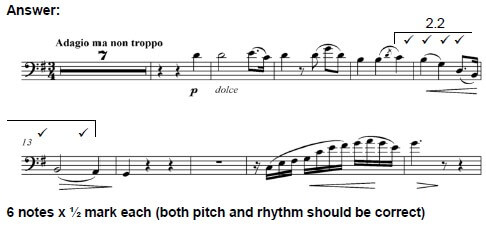
| Play Track 5 ONCE. |
2.3 Identify the compositional technique used at 2.3 in bars 22–24.
Answer: Sequences (1)
| Play Track 6 TWICE. |
2.4 Name the cadence used at 2.4.
Answer: Perfect Cadence (1)
[6]
TOTAL SECTION A: 10
SECTION B: RECOGNITION OF MUSIC CONCEPTS
QUESTION 3: GENERAL LISTENING (COMPULSORY)
Mark THREE items in COLUMN A in QUESTIONS 3.1–3.4 that relate to the music that you hear. Make a cross (X) in THREE appropriate blocks.
3.1 (3)
| Play Track 7 TWICE. |
COLUMN A | Track 7 |
Homophonic Texture | X |
Baroque Period | |
Concerto | X |
Polyphonic Texture | |
Classical Period | X |
Piano Sonata |
3.2 (3)
| Play Track 8 TWICE. |
COLUMN A | Track 8 |
Primary chords | |
A cappella | X |
Polyrhythm | |
Parallel intervals | X |
Ankle rattles | |
Call and response | X |
3.3 (3)
| Play Track 9 TWICE. |
COLUMN A | Track 9 |
Piano | |
Pennywhistle | |
Township Jive | X |
Accordion | X |
Syncopation | X |
Mbaqanga |
3.4 (3)
| Play Track 10 TWICE. |
COLUMN A | Track 10 |
Suspensions | X |
Irregular metre | |
Minor key | X |
Regular metre | X |
Adagio | |
Timpani |
(12 ÷ 3) [4]
Answer QUESTION 4 (WAM) OR QUESTION 5 (JAZZ) OR QUESTION 6 (IAM).
QUESTION 4: WAM
4.1
| Play Track 11 ONCE. |
4.1.1 Identify the brass instrument playing at the beginning of this extract.
Answer: French Horn (1)
| Play Track 11 ONCE again. |
4.1.2 Describe this work with regard to genre, tempo and time signature.
Genre: Symphony (one mark)
Tempo: Allegretto (one mark)
Time signature: 6/8 OR compound duple (one mark) (3)
4.1.3 Provide this extract with a suitable title.
Answer: Shepherds’ Song (1)
4.2
| Play Track 12 ONCE. |
4.2.1 Identify ONE woodwind and ONE string instrument that plays the melody at the beginning of this extract.
Woodwind instrument: Bassoon (one mark)
String instrument: Cello (one mark) (2)
4.2.2 With which ONE of the following genres do you associate this extract? Make a cross (X) in the appropriate block. (1)
![]()
| Play Track 12 ONCE again. |
4.2.3 Identify the composer and give a title for this work.
Composer: Mendelssohn (one mark)
Title: Fingal’s Cave OR The Hebrides Overture (one mark) (2)
4.3
| Play Track 13 TWICE. |
4.3.1 Which style of composition that was predominantly used during the Baroque period is evident in this extract?
Answer: Fugal exposition OR Fugue (1)
4.3.2 Name the subgenre in opera music that is associated with this extract.
Answer: Overture (1)
4.3.3 Identify the composer of this work.
Make a cross (X) in the appropriate block. (1)![]()
4.4
| Play Track 14 TWICE. |
Mark THREE items in COLUMN A that is related to Track 14.
Make a cross (X) in THREE appropriate blocks. (3)
COLUMN A | Track 14 |
Pamina and Papageno | X |
Allegro assai | |
Papageno and Papagena | |
Andantino | X |
Sarastro and chorus | |
Recitative | |
Larghetto | |
Duet | X |
(16 ÷ 2) [8]
OR
QUESTION 5: JAZZ
5.1
| Play Track 15 TWICE. |
5.1.1 Identify the woodwind instrument playing in this extract.
Answer: Clarinet (1)
5.1.2 Identify the South African jazz style.
Answer: Marabi (1)
5.1.3 Name the group that you associate with this extract.
Answer: Manhatten Brothers (1)
5.2
| Play Track 16 TWICE. |
5.2.1 Identify the South African jazz style.
Answer: New Jazz (1)
5.2.2 Give TWO reasons to motivate your answer to QUESTION 5.2.1.
- Featured South African musicians Dollar Brand, Kippie Moeketsi, Jonas Gwangwa and Hugh Masekela all destined to shape South African jazz (one mark)
- Influences of American modern jazz (Bebop) mixed with a more distinctively South African sound (one mark) (2)
| Play Track 16 TWICE. |
5.2.3 Describe the music with regard to typical rhythmical features and time signature(s).
Rhythm: Syncopation
Time signature: Simple quadruple to simple triple (2)
5.2.4 Identify the group performing this work.
Answer: The Jazz Epistles (1)
5.3 Play Track 17 TWICE.
5.3.1 Identify the style and artist that can be heard in this extract.
Answer: Style: Early Jazz (one mark)
Artist: Dolly Rathebe (one mark) (2)
5.3.2 Name ONE chordophone and ONE electrophone instrument featured in this extract.
Chordophone: Piano
Electrophone: Electric Guitar (2)
5.4
| Play Track 18 TWICE. |
Mark THREE items in COLUMN A that is related to Track 18. Make a cross (X) in THREE appropriate blocks. (3)
COLUMN A | Track 18 |
Piano improvisation | |
Blues Notes Band | X |
Dollar Brand | |
Cape Jazz | |
Trumpet improvisation | X |
Brotherhood of Breath | |
Kwela | |
Jazz in exile | X |
(16 ÷ 2) [8]
OR
QUESTION 6: IAM
6.1
| Play Track 19 TWICE. |
6.1.1 Identify the type of African song associated with this extract. Make a cross (X) in the appropriate block.
![]()
6.1.2 Identify ONE vocal technique used in this extract.
Answer: Ululation (1)
6.1.3 Which voice group performs this song?
Answer: Men OR Tenor and Bass (1)
6.2
| Play Track 20 ONCE. |
6.2.1 Identify the South African style.
Answer: Isicathamiya (1)
| Play Track 20 ONCE. |
6.2.2 Describe the instrumentation used in this extract.
Answer: Male voices (one mark)
singing a capella music (one mark) (2)
6.2.3 Identify the group performing in this extract.
Answer: Ladysmith Black Mambazo (1)
6.3
| Play Track 21 ONCE. |
6.3.1 Name and define the style that you hear in this extract.
Answer: Maskanda/Maskandi (one mark)
Virtuoso instrumentalist playing traditional music on Western instruments (one mark) (2)
6.3.2 With which African tribe do you associate this music?
Make a cross (X) in the appropriate block.![]()
| Play Track 21 ONCE. |
6.3.3 Identify ONE prominent chordophone instrument used in this extract.
Answer: Acoustic Guitar (1)
6.3.4 Why is this South African style so closely related to Blues?
Answer: Because of the cyclical, repetitive (one mark) and picking of strings on the guitar (one mark) (2)
6.4
| Play Track 22 TWICE. |
Mark THREE items in COLUMN A that is related to Track 22. Make a cross (X) in THREE appropriate blocks. (3)
COLUMN A | Track 22 |
Djembe | |
Polyrhythm | X |
Philip Tabane | |
Monophonic | |
Free Kiba | X |
Tabla drums | |
Sello Galane | X |
vhaVenda drums |
(16 ÷ 2) [8]
TOTAL SECTION B: 12
QUESTION 7 (COMPULSORY)
Read and study the questions for ONE minute.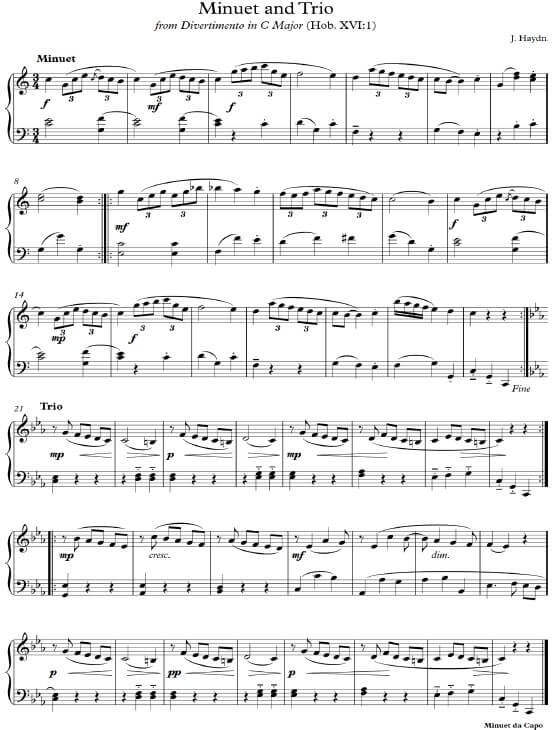
| Play Track 23 ONCE to provide an overview. |
| Play Track 23 ONCE again. |
7.1 Name the overall form of this work.
Answer: Compound Ternary Form OR Minuet and Trio Form (1)
7.2 Give an analysis of the form of the Minuet.
Minuet: (9 ÷ 3) (3)
SECTION | BARS | MAIN KEYS |
A | 1–8 | C major |
B | 9–12 | F–G major |
A1 | 13–20 | C major |
7.3 Give an analysis of the form of the Trio.
Trio: (9 ÷ 3) (3)
SECTION | BARS | MAIN KEYS |
C | 21–28 | C minor |
D | 29–35 | Eb major |
C1 | 36–43 | C minor |
7.4 How is the key of the Trio related to the key of the Minuet?
Answer: Parallel key (C major – C minor) (1)
| Play Track 23 one last time. |
TOTAL SECTION C: 8
GRAND TOTAL: 30
MUSIC PAPER 1 GRADE 12 MEMORANDUM - NSC PAST PAPERS AND MEMOS SEPTEMBER 2016
MUSIC
PAPER ONE (P1)
GRADE 12
EXAM PAPERS AND MEMOS
SEPTEMBER 2016
INSTRUCTIONS AND INFORMATION
- This question paper consists of FIVE sections, namely SECTIONS A, B, C, D and E.
- Answer SECTION A in pencil only in the spaces provided on this question paper.
- Answer SECTION B and C or D or E in blue or black ink in the ANSWER BOOK provided.
- Number the answers correctly according to the numbering system used in this question paper.
- The last page of this question paper is manuscript paper intended for rough work. You may remove this page.
- You may NOT have access to any musical instrument for the duration of this examination.
- Use the table on the next page as a guide for mark and time allocation when answering each question.
- Write neatly and legibly.
SECTION | QUESTION | MARKS | MARKER | MODERATOR |
A: Theory of Music (COMPULSORY) | 1 | 20 | ||
2 | 15 | |||
3 | 10 | |||
4 | 15 | |||
SUBTOTAL | 60 | |||
AND | ||||
B: (COMPULSORY) | 5 | 20 | ||
SUBTOTAL | 20 | |||
AND | ||||
C: WAM | 6 | 10 | ||
7 | 10 | |||
8 | 10 | |||
9 | 10 | |||
SUBTOTAL | 40 | |||
OR | ||||
D: JAZZ | 10 | 10 | ||
11 | 7 | |||
12 | 8 | |||
13 | 15 | |||
SUBTOTAL | 40 | |||
OR | ||||
E: IAM | 14 | 10 | ||
15 | 8 | |||
16 | 7 | |||
17 | 15 | |||
SUBTOTAL | 40 | |||
GRAND TOTAL | 120 | |||
MEMORANDUM
SECTION A: THEORY OF MUSIC (COMPULSORY)
Answer QUESTION 1, QUESTION 2.1 OR QUESTION 2.2, QUESTION 3, AND QUESTION 4.1 OR QUESTION 4.2.
Answer the questions in the spaces provided on this question paper. QUESTION 1
Study the extract from Oboe Sonata, Op. 166 by C. Saint Seans below and answer the questions that follow.
1.1 Name the key of this extract. (1)
D Major |
1.2 Name the type of triad at 1.2, for example diminished triad. (1)
Major Triad OR B Major |
1.3 Give the intervals marked 1.3.1 and 1.3.2, for example major 2nd. (2) ie; (1) × (1)
1.3.1 (1)
Minor 7th |
1.3.2 (1)
Minor 10th OR compound Minor 3rd |
1.4 Transpose the oboe part in bar 16 and 17 for Clarinet in Bb. Insert a new key signature.
Minus ½ a mark per mistake (8 x ½) (4)
1.5 Re-write bar 7 of the piano part in half the note values. Insert a new time signature.
Minus ½ a mark per mistake
½ a mark key signature
½ a mark time signature
½ a mark top part
½ a mark bottom part (4 x ½) (2)
1.6 Improve the grouping in bars 10 and 11 of the oboe part.
Minus ½ a mark per mistake (4 x ½) (2)
1.7 Why are rests not used on beat 2 and 3 in the bass clef in bar 10? (1)
The left hand notes/part is notated in the treble clef. |
1.8 Write the following scales or modes according to the given instruction:
1.8.1 B Dorian mode, descending without key signature. Use the bass clef and minums.
Minus ½ a mark per mistake (6 x ½) (3)
1.8.2 C melodic minor scale, ascending, with key signature. Use the alto clef and minums.
Minus ½ a mark per mistake (12÷3) (4)
[20]
QUESTION 2
ANSWER EITHER QUESTION 2.1 OR QUESTION 2.2.
2.1 Use the opening motif below and complete a 12-bar melody in ABA-form for any single-line melodic instrument of your choice. Indicate the instrument for which you are writing and add dynamics and articulation marks, as well as a tempo indication.
Instrument:
The melody will be marked according to the criteria below:
DESCRIPTION | MARK ALLOCATION | CANDIDATE’S MARK |
Instrument choice (Piano will not be accepted) | 1 | |
Form and cadential points | 3 | |
Musicality Melodic shape, climax, rhythm, musical unity and creativity | 8 | |
Correct notation | 1 | |
Dynamics and articulation | 2 | |
TOTAL | 15 |
[15]
OR
2.2 Use the opening motif below and complete a 12-bar melody in ABA-form for any single-line melodic instrument of your choice. Indicate the instrument for which you are writing and add dynamics and articulation marks, as well as tempo indication.
Instrument:
The melody will be marked according to the criteria below:
DESCRIPTION | MARK ALLOCATION | CANDIDATE’S MARK |
Instrument choice (Piano will not be accepted) | 1 | |
Form and cadential points | 3 | |
Musicality Melodic shape, climax, rhythm, musical unity and creativity | 8 | |
Correct notation | 1 | |
Dynamics and articulation | 2 | |
TOTAL | 15 |
[15]
QUESTION 3
Study the extract from O Ewigkeit, du Donnerwort by J.S. Bach below and answer the questions that follow.
3.1 Figure the chords marked (a) – (d) on the score. Use EITHER figuring symbols below the score OR chord symbols above the score. Note the example answer in bar 1. (4)
(a) F: vi OR F: D minor (b) F: vii° OR F: E diminished (c) F: ii OR F: G minor (d) F: VI OR F: Bb major (4 x 1) |
3.2 Name the cadences at (e) and (f). Write only the name of the cadence below the score in the block provided. (2)
(e) Imperfect cadence (f) Perfect cadence (2 x 1) |
3.3 Name the type of non-chordal notes at (g) to (i). (3)
(g) Lower auxiliary (h) Suspension (i) Unaccented passing note (3 x 1) |
3.4 Name the relative key (major or minor) of this extract. (1)
D minor |
[10]
QUESTION 4
Answer EITHER QUESTION 4.1 (WAM) OR QUESTION 4.2 (JAZZ).
4.1 Complete the four-part vocal harmonisation below by ading the alto, tenor and bass parts. Use atleast TWO non-chordal notes.
The harmonisation will be marked according to the criteria below:
DESCRIPTION | MARK ALLOCATION | CANDIDATE’S MARK |
Choice of chords | 14 (Minus ½ mark per mistake) | |
Correctness Notation, doubling, spacing, voice leading and doubling | 14 (Minus ½ mark per mistake) | |
Use of non-chordal notes | 2 | |
30 (÷ 2) | ||
TOTAL | 15 |
[15]
OR
4.2 Complete the piece below by adding suitable harmonic material in the bass clef.
Ensure that you write in the style of Ragtime.
The harmonisation will be marked according to the criteria below:
DESCRIPTION | MARK ALLOCATION | CANDIDATE’S MARK |
Choice of chords | 16 (2 per bar) (Minus ½ mark per mistake) | |
Correctness Notation, spacing and voice leading | 8 (Minus ½ mark per mistake) | |
General impression | 6 | |
30 (÷ 2) | ||
TOTAL | 15 |
[15]
TOTAL SECTION A: 60
SECTIONS B, C, D, E: GENERAL MUSIC KNOWLEDGE
Answer SECTION B (COMPULSORY)
AND SECTION C (Western Art Music)
OR SECTION D (Jazz)
OR SECTION E (Indigenous African Music)
Answer these questions in an ANSWER BOOK.
SECTION B: GENERAL (COMPULSORY)
QUESTION 5
5.1 Four options are provided as possible answers to the following questions. Choose the answer and write only the letter (A–D) next to the question number in the ANSWER BOOK, for example 5.11 E. (10)
5.1.1 C 5.1.2 B 5.1.3 C 5.1.4 D 5.1.5 D 5.1.6 D 5.1.7 C 5.1.8 C 5.1.9 D 5.1.10 B (10 x 1) |
5.2
5.2.1 South African Music Rights Organisation (1)
5.2.2 Protect musicians’ rights and collect money for songwriters in South Africa and abroad. (1)
5.2.3 2059 (Copyright last for 50 years post death) (1)
5.3
- Register the work with a collection agency
- Post the work to yourself
- A Commissioner of Oath can certify the work (3 x 1) (3)
5.4
5.4.1 True
5.4.2 False
5.4.3 True
5.4.4 False (4 x 1) (4)
TOTAL SECTION B: 20
Answer SECTION C (Western Art Music)
OR SECTION D (Jazz)
OR SECTION E (Indigenous African Music)
SECTION C: WESTERN ART MUSIC (WAM)
QUESTION 6
6.1 Beethoven composed 9 symphonies. (1)
6.2 They are both overtures. (1)
6.3 A symphony is a large scale work in 4 or more movements while a symphonic poem is a one movement work that is normally programmatic in nature. (2)
6.4 Free Masonary (1)
6.5 The Wedding March OR A Midsummer Night’s dream OR the hymn tune “Hark the Herald Angels Sing”. (2)
6.6 Piano/Violin Sonata, Oratorio, Symphony, Chamber music (Any 2 x 1) (2)
6.7 Opera seria refers to operas with a serious theme/story while opera comique is light hearted and comedic in nature. (2)
[10]
QUESTION 7
7.1
7.1.1 The name Mannheim School refers to a group of composers and musicians that worked at the court of Duke Carl Theodor in Mannheim, Germany, where the best composers where brought together. (2)
7.1.2 ∙
- Melodic prominence given to the violins
- Clarinet brought into orchestra
- Harpsichord no longer used
- Continuo part replaced by written parts for all instruments
- Addition of orchestral effects, e.g. the tremolo and broken chord in rapid notes.
- Replaced contrapuntal writing with homophonic texture
- Effective use of crescendo and diminuendo.
- Established the sections of sonata form and the four-movement symphony structure
- The Minuet and Trio is added as the third movement. (Any 5 x 1) (5)
7.2
7.2.1 B
7.2.2 C
7.2.3 A (3 x 1) (3)
[10]
QUESTION 8
8.1 Use the following list of elements to write a paragraph on the style characteristics of the Romantic period.
- Melody
- Song-like melodies (Lyrical)
- Wide leaps, e.g. 6ths, 7ths, diminished
- Augmented intervals are used for expressive purposes
- Phrases not so regular and balanced as in the Classical Period - Melody with accompaniment frequently used (1)
- Harmony
- Many dischords
- Chords used as a means of expressive colour
- Development of chromatic harmonies
- Freer use of non-harmonic tones and chromatic voice leading
- Often use 9th, 11th and 13th chords (1)
- Tonality
- Sudden key changes were common
- Interchange of harmonies and keys from major to minor and vice versa was common
- Distant modulations, tonal ambiguity, and tendency to avoid
- distinct cadences (1)
- Texture
- Use a wide range of pitch, dynamics and tone colours
- Dense textures were common
- Textures change within a piece (1)
- Rhythm
- Freedom and flexibility of rhythm
- Rhythms tend to be less vital, and more focus on lyrical, expressive melodies
- Sometimes use movements based on one unbroken rhythmic pattern and cross-rhythms (1)
Any ONE characteristic for each element. |
8.2 The Hebrides Overture Op. 26 is in B minor and written in sonata form. The instrumentation consists of strings (Violin, viola, cello, double bass), 2 flutes, 2 oboes, 2 clarinets, 2 bassoons, 2 horns, 2 trumpets and timpani. (4)
8.3 The music was inspired by Mendelssohn’s boat trip to the Fingals cave on the island of Staffa off the west coast of Scotland, which is known for its weird echoes. (1)
[10]
QUESTION 9
First movement – Awakening of cheerful feelings on arrival in the countryside.
- Time signature: 2/4
- Key: F major
- Form: Written in sonata form
Any THREE of the following: |
- A leisurely movement in which the brook murmurs in quavers or semiquavers almost throughout.
- The first subject is built up of five figures, which are used throughout the movement.
- Scored for flute, oboe, clarinet in Bb, bassoon, horn and strings
Fourth Movement – Thunderstorm
- Time signature: 4/4
- Key: F minor
- Form: Programme music
Any THREE of the following: |
- The 4th movement depicts a violent thunderstorm with painstaking realism, building from just a few drop or rain to a great climax with thunder, lightning, high winds and sheets of rain. The storm eventually passes with an occasional peal of thunder still heard in the distance. There is a seamless transition into the final movement.
- The pp staccato quavers played by the violins in bar 3 give the effect of the first raindrops.
- The drums enter for the first time in bar 21, representing the first big roll of thunder.
- Two additional trombones enter for the first time in bar 106 giving additional strength when the storm reaches its climax.
- The storm reaches its climax with tremolos and drum rolls.
2 Marks for language and style |
(16 ÷1.6) [10]
TOTAL SECTION C: 40
OR
SECTION D: JAZZ
QUESTION 10
10.1 New Orleans (1)
10.2 The Jazz Epistles (1)
10.3 Dolly Rathebe, Thandi Klaasen (2)
10.4 Kwela, a pennywhistle-based street music developed in South Africa. (1)
10.5 Fusion (1)
10.6 Piano (1)
10.7 The Blue Notes (1)
10.8
10.8.1 Pata Pata (1)
10.8.2 1989 (1)
[10]
QUESTION 11
- Known as one of the greatest pennywhistlers in South Africa.
- Performed/composed in Kwela style: Kwela is a pennywhistle-based street music. This style developed in South Africa blending with the music of Malawian immigrants. Uses simple chord progressions which are made up mostly of primary chords (I, IV, and V).
- Spokes claims that the inspiration for his songs come from his dreams.
- Albums included King Kwela, Ace Blues, Kwela Spokes, Chobolo, Sono Sam. (Only ONE album)
[7]
QUESTION 12
12.1
- Voice is a jazz quintet consisting of some of South Africa’s leading jazz musicians. The group includes musicians such as Andile Yenana (Piano), Sydney Mnisi (Saxophone), Marcus Wyatt (Trumpet), Herbie Tsoaeli (Bass), Morabo Morojele (Drums).
- Voice is inspired by early jazz musicians such as Abdullah Ibrahim. There compositions are in Marabi and Kwela styles. They are also influenced by bebop and Latin Jazz. (4)
12.2
12.2.1 True
12.2.2 True
12.2.3 False
12.2.4 False (4 x 1) (4)
[8]
QUESTION 13
- The Jazz Epistles were made up of 6 members. It included Dollar Brand, later known as Abdullah Ibrahim (Piano), Kippie Moeketsi (Alto Saxophone), Jonas Gwangwa (Trombone), Hugh Masekela (Trumpet), Johnny Gertze (Bass) and Early Mabuza OR Makaya Ntshoko (Drums).
- They were the first important Bebop band in South Africa. Bebop is a style of jazz characterised by a fast tempo, instrumental virtuosity and improvisation.
- This style began during the mid-1940’s in the USA and aimed to counter the popular swing style of the time with a new non-danceable style of music.
- The music contained advanced harmonies, complex syncopation and the role of the rhythm section was expanded. During the apartheid system, jazz offered a way to protest against the political system of the time. The South African government made numerous attempts at suppressing the music by controlling radio broadcasts and raiding jazz clubs.
- First album by Jazz Epistles was ‘Jazz Epistle, Verse 1
[15]
TOTAL SECTION D: 40
OR
SECTION E: INDIGENOUS AFRICAN MUSIC (IAM)
QUESTION 14
14.1 Chordophone (1)
14.2 A singer, storyteller, praise singer that presents a series of important events through song or praise or narrative. (2)
14.3 An ululation is a long, wavering, high-pitched vocal sound resembling a howl with a trilling quality. (1)
14.4 Mbaqanga (1)
14.5 The mixed structural form is a combination of call and response, call and refrain and call and chorus refrain. An ending sentence/phrases is not used to respond to the call. (2)
14.6 Beatboxing (1)
14.7
- Comprises of eight to ten “pipe blowers” and three drum beaters.
- Lyrics are in many different languages including isiZulu, Shona and Northen Ndebele, Sepedi. (2)
[10]
QUESTION 15
Definition of the word
- The word originates from the Zulu word ‘Cothoza’ which means to ‘walk on one’s toes lightly’.
- It was originally sung by the workers in the early Natal Province where they held competitions amongst each other.
- It is known as a Zulu style that is just as famous as maskanda music. ∙ Isicathamiya was made famous by the SA group, Ladysmith Black Mambazo.
- The word ‘Isicathamiya’ is derived from the word cathama which means to crawl like a cat or walk on your toes as the workers were compelled to practice their dance moves softly in the evenings. (2)
Characteristics of the music
- It is in the style of a capella harmonious singing. It is a style where men sing without accompaniment.
- Uses call and response between the leader and the group.
- Singing generally in four parts.
- Vocal techniques such as crepitation and ululation.
- Lyrics mostly in isiZulu and choreography is derived from traditional isiZulu dancing. (4)
ONE important album and its composer(s)
- Ladysmith Black Mambazo (Shaka Zulu/Long walk to Freedom/Journey of Dreams/Gift of the Tortoise/Songs from Zulu-Farm) (2)
Any 1 album |
[8]
QUESTION 16
Style/Characteristics
- Afro Soul is the term given to the music genre that is a fusion between soul music (A style that combines elements of gospel, rhythm and blues and jazz) and African music. (3)
Instrumentation
- A distinct feature of Afro Soul is the strong influence of vocals. The instrumentation consists mainly of drums, bass, guitar and vocal (AND backing vocals) (4 ÷ 2) (2)
TWO artists
- Artists such as Hugh Masekela and Mirriam Makeba composed in an Afro Soul style. (2)
[7]
QUESTION 17
Cultural origins (any TWO)
- Maskandi means a virtuoso instrumentalist who plays traditional music on Western instruments.
- Traditionally maskandi music consists of a song evolving with the singers’ (usually a male singer) real life experiences, his daily joys etc.
- The term Maskanda comes from the Afrikaans word “musikant” which means musician, and is associated with Zulu folk music.
- Maskandi is a kind of Zulu folk music that has evolved within South African society, particularly in Kwazulu-Natal. (2)
Typical instrumentation
- Typical instrumentation consists of a concertina, acoustic guitar, bass guitar, keyboards, synthesizer, drums and backing vocalists. Normally associated with the guitar. (5)
Style characteristics of the music
- Traditional songs begin with a flourish on the guitar or accordion and is referred to as “izihlabo” – “This is what I am going to play and this is who I am.”
- The guitar is not tuned the same as the traditional tuning. Lyrical content includes praise, storytelling and migrant culture.
- People dance, play drums and clap hands in different ways and the dances that is portrayed signifies the district or area where the maskandi orginated.
- The frontman’s natural personality is a key element in the music.
- Use of rapidly spoken sections of Zulu praise poetry, called “izibongo”.
- Known as “Zulu Blues”, because of the cyclical repetitive and picking strings on the guitar. (5)
THREE artists that were influential in exposing Maskandi to the international market.
- Artists like Johnston Zibokwakhe Mnyandu, Bhodloza Nzimande, Amatshitshi Amhlophe, Amashayina Amahle, Siyani Ngcobo, Imithente, Inkunzi Emdaka and Izingane Zoma contributed in exposing Maskandi to the international market. (3)
[15]
TOTAL SECTION E: 40
GRAND TOTAL: 120
MUSIC PAPER 1 GRADE 12 QUESTIONS - NSC PAST PAPERS AND MEMOS SEPTEMBER 2016
MUSIC
PAPER ONE(P1)
GRADE 12
EXAM PAPERS AND MEMOS
SEPTEMBER 2016
INSTRUCTIONS AND INFORMATION
- This question paper consists of FIVE sections, namely SECTIONS A, B, C, D and E.
- Answer SECTION A in pencil only in the spaces provided on this question paper.
- Answer SECTION B and C or D or E in blue or black ink in the ANSWER BOOK provided.
- Number the answers correctly according to the numbering system used in this question paper.
- The last page of this question paper is manuscript paper intended for rough work. You may remove this page.
- You may NOT have access to any musical instrument for the duration of this examination.
- Use the table on the next page as a guide for mark and time allocation when answering each question.
- Write neatly and legibly.
MARKING GRID
SECTION | QUESTION | MARKS | MARKER | MODERATOR |
A: Theory of Music (COMPULSORY) | 1 | 20 | ||
2 | 15 | |||
3 | 10 | |||
4 | 15 | |||
SUBTOTAL | 60 | |||
AND | ||||
B: (COMPULSORY) | 5 | 20 | ||
SUBTOTAL | 20 | |||
AND | ||||
C: WAM | 6 | 10 | ||
7 | 10 | |||
8 | 10 | |||
9 | 10 | |||
SUBTOTAL | 40 | |||
OR | ||||
D: JAZZ | 10 | 10 | ||
11 | 7 | |||
12 | 8 | |||
13 | 15 | |||
SUBTOTAL | 40 | |||
OR | ||||
E: IAM | 14 | 10 | ||
15 | 8 | |||
16 | 7 | |||
17 | 15 | |||
SUBTOTAL | 40 | |||
GRAND TOTAL | 120 | |||
QUESTIONS
SECTION A: THEORY OF MUSIC (COMPULSORY)
Answer QUESTION 1, QUESTION 2.1 OR QUESTION 2.2, QUESTION 3, AND QUESTION 4.1 OR QUESTION 4.2.
Answer the questions in the spaces provided on this question paper.
QUESTION 1
Study the extract from Oboe Sonata, Op. 166 by C. Saint Seans below and answer the questions that follow.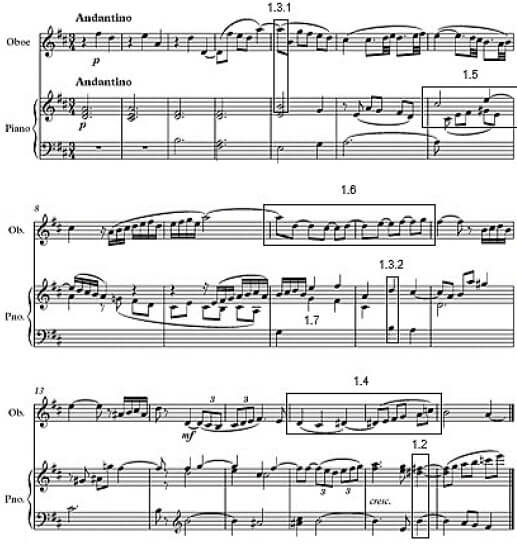
1.1 Name the key of this extract. (1)
1.2 Name the type of triad at 1.2, for example diminished triad. (1)
1.3 Give the intervals marked 1.3.1 and 1.3.2, for example major 2nd.
1.3.1 ——————————————————————————————
1.3.2——————————————————————————————(2)
1.4 Transpose the oboe part in bar 16 and 17 for Clarinet in Bb. Insert a new key signature. 
1.5 Re-write bar 7 of the piano part in half the note values. Insert a new time signature. 
1.6 Improve the grouping in bars 10 and 11.
1.7 Why are rests not used on beat 2 and 3 in the bass clef in bar 10? (1)
1.8 Write the following scales or modes according to the given instruction:
1.8.1 B Dorian mode, descending without key signature. Use the bass clef and minums. 
1.8.2 C melodic minor scale, ascending, with key signature. Use the alto clef and minums. 
[20]
QUESTION 2
ANSWER EITHER QUESTION 2.1 OR QUESTION 2.2.
2.1 Use the opening motif below and complete a 12-bar melody in ABA-form for any single-line melodic instrument of your choice. Indicate the instrument for which you are writing and add dynamics and articulation marks, as well as a tempo indication.
Instrument: —————————————————————————————————————————————————
The melody will be marked according to the criteria below:
DESCRIPTION | MARK ALLOCATION | CANDIDATE’S MARK |
Instrument choice | 1 | |
Form and cadential points | 3 | |
Musicality | 8 | |
Correct notation | 1 | |
Dynamics and articulation | 2 | |
TOTAL | 15 |
[15]
OR
2.2 Use the opening motif below and complete a 12-bar melody in ABA-form for any single-line melodic instrument of your choice. Indicate the instrument for which you are writing and add dynamics and articulation marks, as well as tempo indication.
Instrument: —————————————————————————————————————————————————
The melody will be marked according to the criteria below:
DESCRIPTION | MARK ALLOCATION | CANDIDATE’S MARK |
Instrument choice | 1 | |
Form and cadential points | 3 | |
Musicality | 8 | |
Correct notation | 1 | |
Dynamics and articulation | 2 | |
TOTAL | 15 |
[15]
QUESTION 3
Study the extract from O Ewigkeit, du Donnerwort by J.S. Bach below and answer the questions that follow.
3.1 Figure the chords marked (a) – (d) on the score. Use EITHER figuring symbols below the score OR chord symbols above the score. Note the example answer in bar 1. (4)
3.2 Name the cadences at (e) and (f). Write only the name of the cadence below the score in the block provided. (2)
3.3 Name the type of non-chordal notes at (g) to (i).
(g) —————————————————————————————————————————————————
(h) —————————————————————————————————————————————————
(i) ————————————————————————————————————————————————— (3)
3.4 Name the relative key (major or minor) of this extract. (1)
[10]
QUESTION 4
Answer EITHER QUESTION 4.1 (WAM) OR QUESTION 4.2 (JAZZ).
4.1 Complete the four-part vocal harmonisation below by ading the alto, tenor and bass parts. Use at least TWO non-chordal notes.
The harmonisation will be marked according to the criteria below:
DESCRIPTION | MARK ALLOCATION | CANDIDATE’S MARK |
Choice of chords | 14 (Minus ½ mark per mistake) | |
Correctness | 14 (Minus ½ mark per mistake) | |
Use of non-chordal notes | 2 | |
30 (÷ 2) | ||
TOTAL | 15 |
[15]
OR
4.2 Complete the piece below by adding suitable harmonic material in the bass clef. Ensure that you write in the style of Ragtime.
The harmonisation will be marked according to the criteria below:
DESCRIPTION | MARK ALLOCATION | CANDIDATE’S MARK |
Choice of chords | 16 (2 per bar) (Minus ½ mark per mistake) | |
Correctness | 8 (Minus ½ mark per mistake) | |
General impression | 6 | |
30 (÷ 2) | ||
TOTAL | 15 |
[15]
TOTAL SECTION A: 60
SECTIONS B, C, D, E: GENERAL MUSIC KNOWLEDGE
Answer SECTION B (COMPULSORY)
AND SECTION C (Western Art Music)
OR SECTION D (Jazz)
OR SECTION E (Indigenous African Music)
Answer these questions in an ANSWER BOOK.
SECTION B: GENERAL (COMPULSORY)
QUESTION 5
5.1 Four options are provided as possible answers to the following questions. Choose the answer and write only the letter (A–D) next to the question number in the ANSWER BOOK, for example 5.11 E.
5.1.1 The three types of minor scales are:
- Harmonic, Pentatonic, Chromatic.
- Natural, Blues, Major.
- Harmonic, Melodic, Natural.
- Wholetone, Natural, Chromatic (1)
5.1.2 Which note is raised in a chord when using a Tierce de Picardie?
- 1
- 3
- 7
- 5 (1)
5.1.3 The Cor anglais belongs to which instrumental family?
- Brass
- Percussion
- Woodwind
- Strings (1)
5.1.4 Rondo is usually associated with which movement of a sonata/symphony?
- 1st
- 2nd
- 3rd
- 4th (1)
5.1.5 How many semi-quavers fit into a dotted semibreve?
- 8
- 14
- 12
- 24 (1)
5.1.6 Which THREE elements define musical form?
- Variation, Barlines, Melody.
- Tone, Repetition, Articulation.
- Contrast, Dynamics, Tone.
- Repetition, Variation, Form. (1)
5.1.7 Which ONE of the following is not an articulation marking?
- Staccato
- Tenuto
- Fermata
- Legato (1)
5.1.8 A cappella refers to a …
- sudden increase in tempo.
- concerto soloist.
- work performed without accompaniment.
- trombone mute. (1)
5.1.9 A chromatic interval refers to an interval where …
- two notes sound together.
- both intervals are in the given key.
- one or both notes are inverted.
- one or both notes are not in the given key. (1)
5.1.10 A Coda is generally found …
- after a key change.
- at the end of the piece.
- within the development.
- before the exposition. (1)
5.2 Answer the following questions.
5.2.1 What does the accronym SAMRO mean? (1)
5.2.2 What is the function of SAMRO? (1)
5.2.3 Michael Jackson died in 2009. In what year will the copyright expire on his compositions? (1)
5.3 Give THREE ways in which a new composition can be registered. (3)
5.4 Complete the following by saying whether the following statements are TRUE or FALSE.
5.4.1 Pirate recordings are legitimate recordings that are illegally copied.
5.4.2 Music piracy does not have a negative effect on the music industry.
5.4.3 Copyright allows composers to reproduce and distribute their music.
5.4.4 Online piracy refers to the downloading of films only. (4 x 1) (4)
TOTAL SECTION B: 20
Answer SECTION C (Western Art Music)
OR SECTION D (Jazz)
OR SECTION E (Indigenous African Music)
SECTION C: WESTERN ART MUSIC (WAM)
QUESTION 6
6.1 How many symphonies did Beethoven compose? (1)
6.2 What is the similarity between Fingals Cave Op.26 and the opening of The Magic Flute? (1)
6.3 What is the difference between a symphony and symphonic poem? (2)
6.4 Which ancient secret order was referenced in The Magic Flute? (1)
6.5 Name ONE famous work by Mendelssohn (Other than Fingal’s Cave). (2)
6.6 Apart from opera, give TWO genres in which Mozart composed. (2)
6.7 What is the difference between opera seria and opera comique? (2)
[10]
QUESTION 7
7.1 The Mannheim School played a significant role in the development of the orchestra and symphony.
7.1.1 What is the Mannheim School? (2)
7.1.2 Give FIVE stylistic developments that the Mannheim School introduced. (5)
7.2 Match the voice type in COLUMN B with the character in COLUMN A. Write only the letter (A–C) next to the question number (7.2.1–7.2.3) in the ANSWER BOOK, for example 7.2.4 E.
| COLUMN A | COLUMN B |
7.2.1 Sarastro | A Coloratura Soprano |
(3 x 1) (3)
[10]
QUESTION 8
8.1 Use the following list of elements to write a paragraph on the style characteristics of the Romantic period.
- Melody (1)
- Harmony (1)
- Tonality (1)
- Texture (1)
- Rhythm (1)
8.2 Describe the Hebrides Overture Op. 26 by Mendelssohn by giving the key, form and basic instrumentation of the work. (4)
8.3 Where did Mendelssohn find the inspiration for the Hebrides Overture? (1)
[10]
QUESTION 9
Write an article for the Gramophone magazine readers, where you describe the FIRST and FOURTH movement of Beethoven’s Symphony no.6 Op. 68. Refer to the following guidelines:
- Movement titles (2)
- Time signatures (2)
- Keys (2)
- Forms (2)
- Any THREE features of the movements (6)
- Style and language (2) (16 ÷1.6)
[10]
TOTAL SECTION C: 40
OR
SECTION D: JAZZ
QUESTION 10
10.1 In what city is jazz said to have originated? (1)
10.2 Which jazz group composed “vary-oo-vum”? (1)
10.3 Other than Miriam Makeba, give TWO examples of an early jazz singer. (2)
10.4 Where did Kwela originate? (1)
10.5 Which style of jazz makes use of both rock and funk? (1)
10.6 What instrument does Abdullah Ibrahim play? (1)
10.7 Which South African group released the album “Township Bop”? (1)
10.8
10.8.1 What is the name of Miriam Makeba’s international hit? (1)
10.8.2 In what year was this song released? (1)
[10]
QUESTION 11
You are asked to write a short press release for an upcoming tribute to Spokes Mashiyane. Your article should include the following information:
- His main instrument (1)
- Musical style and characteristics of that style (4)
- Musical inspiration (1)
- ONE album (1)
[7]
QUESTION 12
12.1 Write brief notes on the jazz group Voice. Your notes should include the following:
- TWO band members
- Style and Influences of the group (4)
12.2 Say whether the following statements are TRUE of FALSE.
12.2.1 Bebop makes use of fast scales and arpeggio.
12.2.2 Marabi style is deeply rooted in ragtime and blues.
12.2.3 Kwela consists of SEVEN different chord changes.
12.2.4 Mbaqanga is a style of South African music with Xhosa roots. (4 x 1) (4)
[8]
QUESTION 13
The Jazz Epistles were the first important band of its kind in South Africa.
Write an essay outlining the bands career with reference to the following points:
- Band members (6 ÷ 2) (3)
- Instruments (6 ÷ 2) (3)
- Characteristics of the music (5)
- The characterisation of Jazz during the Apartheid era (2)
- ONE album (1)
- Style and language (1)
[15]
TOTAL SECTION D: 40
OR
SECTION E: INDIGENOUS AFRICAN MUSIC (IAM)
QUESTION 14
14.1 An Uhadi belongs to which musical instrument category? (1)
14.2 What is a Chronicler? (2)
14.3 Define the term Ululation. (1)
14.4 Which style would you associate with Dolly Rathebe? (1)
14.5 What is meant by ‘The mixed structural form’? (2)
14.6 Give a modern term for ‘Mouth Drumming’ (1)
14.7 Give TWO style characteristics of free kiba music. (2)
[10]
QUESTION 15
You are asked to write a short press release for an Isicathamiya choir competition.
Your article should include the following information:
- Definition of the word (2)
- Characteristics of the music (4)
- ONE important album and its composer/s (2)
[8]
QUESTION 16
Write a Wikipedia entry on Afro Soul, where you describe the style/characteristics of the music as well as the typical instrumentation. Give TWO examples of South African Afro Soul artists.
- Style/Characteristics (3) ∙
- Instrumentation (4 ÷ 2) (2) ∙
- TWO artists (2)
[7]
QUESTION 17
Write an essay where you describe Maskandi music. Include the following aspects in your essay:
- Cultural origins (2) ∙
- Typical instrumentation (5) ∙
- Style characteristics of the music (5)
- THREE artists that were influential in exposing Maskandi to the international market. (3)
[15]
TOTAL SECTION E: 40
ROUGH WORK
MUSIC PAPER 2 GRADE 12 QUESTIONS - NSC PAST PAPERS AND MEMOS SEPTEMBER 2016
MUSIC
PAPER TWO (P2)
GRADE 12
EXAM PAPERS AND MEMOS
SEPTEMBER 2016
INSTRUCTIONS AND INFORMATION
- This question paper consists of THREE sections:
SECTION A (Aural) (10)
SECTION B (Recognition) (12)
SECTION C (Form) (8) - QUESTION 1, QUESTION 2, QUESTION 3 and QUESTION 7 are COMPULSORY.
- Answer QUESTION 4 (WESTERN ART MUSIC – WAM) OR QUESTION 5 (JAZZ) OR QUESTION 6 (INDIGENOUS AFRICAN MUSIC – IAM).
- Candidates must write their answers on this question paper. Use a pencil for music notation and blue or black ink for the other answers.
- This examination will be written while candidates listen to a CD.
- The music teacher at the centre must conduct the examination in the presence of the invigilator.
- The last page of the question paper is manuscript paper intended for rough work. It may be removed by the candidate.
- Candidates may NOT have access to any musical instrument for the duration of this examination.
- Write neatly and legibly.
INSTRUCTION TO THE PERSON OPERATING THE SOUND EQUIPMENT
- The instructions for the music teacher appears in the frames.
- Each musical extract (track) must be played the number of times specified in the question paper.
- Allow enough time between tracks to allow candidates time to think and write their answers before playing the next track.
- The number of the track must be announced clearly each time before it is played.
- If a school offers more than one stream (WAM, JAZZ, IAM), the following guidelines must be followed:
- Each stream must write the examination in a separate venue.
- Each venue must be equipped with suitable sound equipment.
- Each venue must have its own CD with musical extracts
- An invigilator must be present in each venue.
- The tracks have to be played as follows:
- WAM candidates: Tracks 1 to 14 and Track 23.
- JAZZ candidates: Tracks 1 to 10; Tracks 15 to 18 and Track 23.
- IAM candidates: Tracks 1 to 10 and Tracks 19 to 23.
- A battery-powered CD player must be available In case of a power failure.
MARKING GRID
SECTION A: AURAL | TOTAL | MARKER | MODERATOR |
QUESTION 1 (COMPULSORY) | 4 | ||
QUESTION 2 (COMPULSORY) | 6 | ||
SUBTOTAL | 10 |
SECTION B: RECOGNITION | TOTAL | MARKER | MODERATOR |
QUESTION 3 (COMPULSORY) | 4 | ||
AND | |||
QUESTION 4 (WAM) | 8 | ||
OR | |||
QUESTION 5 (JAZZ) | 8 | ||
OR | |||
QUESTION 6 (IAM) | 8 | ||
SUBTOTAL | 12 | ||
SECTION C: FORM | TOTAL | MARKER | MODERATOR |
QUESTION 7 (COMPULSORY) | 8 | ||
SUBTOTAL | 8 |
GRAND TOTAL | 30 |
QUESTIONS
SECTION A: AURAL
QUESTION 1 (COMPULSORY)
| Play Track 1 THREE times. Pause for 30 seconds in between. |
1.1 Listen to the melodic and rhythmic phrase. Notate the rhythm of the missing notes in bars 2–3 below.

| Play Track 1 ONCE more. |
| Play Track 2 TWICE in succession. |
1.2 Make a cross (X) in the block next to the correct time signature of this extract.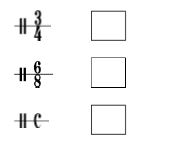
[4]
QUESTION 2 (COMPULSORY)
| Play Track 3 ONCE to provide a general overview. |
Listen to the extract from the second movement of Cello Concerto, Op. 104 by A. Dvořák. Answer the questions that follow. 
| Play Track 4 TWICE. |
2.1 Name the interval at 2.1, for example Major 3rd. (1)
| Play Track 4 FOUR times. Pause ONE minute between each repetition. |
2.2 Fill in the missing notation at 2.2 in bars 12 and 13. (3)
| Play Track 5 ONCE. |
2.3 Identify the compositional technique used at 2.3 in bars 22–24. (1)
| Play Track 6 TWICE. |
2.4 Name the cadence used at 2.4. (1)
[6]
TOTAL SECTION A: 10
SECTION B: RECOGNITION OF MUSIC CONCEPTS
QUESTION 3: GENERAL LISTENING (COMPULSORY)
Mark THREE items in COLUMN A in QUESTIONS 3.1–3.4 that relate to the music that you hear. Make a cross (X) in THREE appropriate blocks.
3.1 (3)
| Play Track 7 TWICE. |
COLUMN A | Track 7 |
Homophonic Texture | |
Baroque Period | |
Concerto | |
Polyphonic Texture | |
Classical Period | |
Piano Sonata |
3.2 (3)
| Play Track 8 TWICE. |
COLUMN A | Track 8 |
Primary chords | |
A cappella | |
Polyrhythm | |
Parallel intervals | |
Ankle rattles | |
Call and response |
3.3 (3)
| Play Track 9 TWICE. |
COLUMN A | Track 9 |
Piano | |
Pennywhistle | |
Township Jive | |
Accordion | |
Syncopation | |
Mbaqanga |
3.4 (3)
| Play Track 10 TWICE. |
COLUMN A | Track 10 |
Suspensions | |
Irregular metre | |
Minor key | |
Regular metre | |
Adagio | |
Timpani |
(12 ÷ 3) [4]
Answer QUESTION 4 (WAM) OR QUESTION 5 (JAZZ) OR QUESTION 6 (IAM).
QUESTION 4: WAM
4.1
| Play Track 11 ONCE. |
4.1.1 Identify the brass instrument playing at the beginning of this extract. (1)
| Play Track 11 ONCE again |
4.1.2 Describe this work with regard to genre, tempo and time signature.
Genre:
Tempo:
Time signature: (3)
4.1.3 Provide this extract with a suitable title. (1)
4.2
| Play Track 12 ONCE. |
4.2.1 Identify ONE woodwind and ONE string instrument that plays the melody at the beginning of this extract.
Woodwind instrument:
String instrument: (2)
4.2.2 With which ONE of the following genres do you associate this extract? Make a cross (X) in the appropriate block.
| Chamber music | Concerto | Symphony | Concert overture |
(1)
| Play Track 12 ONCE again. |
4.2.3 Identify the composer and give a title for this work.
Composer:
Title: (2)
4.3
| Play Track 13 TWICE. |
4.3.1 Which style of composition that was predominantly used during the Baroque period is evident in this extract? (1)
4.3.2 Name the subgenre in opera music that is associated with this extract. (1)
4.3.3 Identify the composer of this work.
Make a cross (X) in the appropriate block.
| Bach | Mozart | Mendelssohn | Chopin |
(1)
4.4
| Play Track 14 TWICE. |
Mark THREE items in COLUMN A that is related to Track 14.
Make a cross (X) in THREE appropriate blocks.
COLUMN A | Track 14 |
Pamina and Papageno | |
Allegro assai | |
Papageno and Papagena | |
Andantino | |
Sarastro and chorus | |
Recitative | |
Larghetto | |
Duet |
(3)
(16 ÷ 2) [8]
OR
QUESTION 5: JAZZ
5.1
| Play Track 15 TWICE. |
5.1.1 Identify the woodwind instrument playing in this extract. (1)
5.1.2 Identify the South African jazz style. (1)
5.1.3 Name the group that you associate with this extract. (1)
5.2
| Play Track 16 TWICE. |
5.2.1 Identify the South African jazz style. (1)
5.2.2 Give TWO reasons to motivate your answer to QUESTION 5.2.1. (2)
| Play Track 16 TWICE. |
5.2.3 Describe the music with regard to typical rhythmical features and time signature(s).
Rhythm:
Time signature: (2)
5.2.4 Identify the group performing this work. (1)
5.3
| Play Track 17 TWICE. |
5.3.1 Identify the style and artist that can be heard in this extract. (2)
5.3.2 Name ONE chordophone and ONE electrophone instrument featured in this extract.
Chordophone:
Electrophone: (2)
5.4
| Play Track 18 TWICE. |
Mark THREE items in COLUMN A that is related to Track 18. Make a cross (X) in THREE appropriate blocks.
COLUMN A | Track 18 |
Piano improvisation | |
Blues Notes Band | |
Dollar Brand | |
Cape Jazz | |
Trumpet improvisation | |
Brotherhood of Breath | |
Kwela | |
Jazz in exile |
(3)
(16 ÷ 2) [8]
OR
QUESTION 6: IAM
6.1
| Play Track 19 TWICE. |
6.1.1 Identify the type of African song associated with this extract. Make a cross (X) in the appropriate block. (1)
| Funeral song | Work song | Initiation song | Wedding song |
6.1.2 Identify ONE vocal technique used in this extract. (1)
6.1.3 Which voice group performs this song? (1)
6.2
| Play Track 20 ONCE. |
6.2.1 Identify the South African style. (1)
| Play Track 20 ONCE. |
6.2.2 Describe the instrumentation used in this extract. (2)
6.2.3 Identify the group performing in this extract. (1)
6.3
| Play Track 21 ONCE. |
6.3.1 Name and define the style that you hear in this extract. (2)
6.3.2 With which African tribe do you associate this music?
Make a cross (X) in the appropriate block. (1)
| AmaZulu | AmaXhosa | AmaSwazi | AmaNdebele |
| Play Track 21 ONCE. |
6.3.3 Identify ONE prominent chordophone instrument used in this extract. (1)
6.3.4 Why is this South African style so closely related to Blues? (2)
6.4
| Play Track 22 TWICE. |
Mark THREE items in COLUMN A that is related to Track 22. Make a cross (X) in THREE appropriate blocks.
COLUMN A | Track 22 |
Djembe | |
Polyrhythm | |
Philip Tabane | |
Monophonic | |
Free Kiba | |
Tabla drums | |
Sello Galane | |
vhaVenda drums |
(3)
(16 ÷ 2) [8]
TOTAL SECTION B: 12
SECTION C : FORM
QUESTION 7 (COMPULSORY)
Read and study the questions for ONE minute.
| Play Track 23 ONCE to provide an overview. |
| Play Track 23 ONCE again. |
7.1 Name the overall form of this work. (1)
7.2 Give an analysis of the form of the Minuet. (9 ÷ 3) (3)
Minuet:
SECTION | BARS | MAIN KEYS |
7.3 Give an analysis of the form of the Trio. (9 ÷ 3) (3)
Trio:
SECTION | BARS | MAIN KEYS |
7.4 How is the key of the Trio related to the key of the Minuet? (1)
| Play Track 23 one last time. |
TOTAL SECTION C: 8
GRAND TOTAL: 30
ROUGH WORK:
HISTORY PAPER 1 GRADE 12 ADDENDUM - NSC PAST PAPERS AND MEMOS SEPTEMBER 2016
HISTORY
PAPER ONE (P1)
GRADE 12
NSC PAST PAPERS AND MEMOS
SEPTEMBER 2016
ADDENDUM
SECTION A: SOURCE-BASED QUESTIONS
QUESTION 1: HOW DID THE BERLIN CRISIS INTENSIFY THE COLD WAR TENSIONS BETWEEN THE UNITED STATES OF AMERICA AND THE SOVIET UNION IN THE 1960s?
SOURCE 1A
This source explains the reasons why the Soviet Union decided to build a wall to separate East Berlin from West Berlin.
The existence of West Berlin, a conspicuously (easily noticed) capitalist city deep within communist East Germany, ‘stuck like a bone in the Soviet throat,’ as Soviet leader Nikita Khrushchev put it. The Russians began manoeuvring (attempting/trying) to drive the United States, Britain and France out of the city for good. In 1948, a Soviet blockade of West Berlin aimed to starve the western Allies out of the city. Instead of retreating, however, the United States and its allies supplied their sectors of the city from the air. This effort, known as the Berlin Airlift, lasted for more than a year and delivered more than 2,3 million tons of food, fuel and other goods to West Berlin. The Soviets called off the blockade in 1949. [From: www.history.com/topics/cold-war/berlin-wall. Accessed on 29 October 2015.] |
SOURCE 1B
This source explains how the actual construction of the Berlin Wall increased tensions between the United States of America and the Soviet Union.
| In the early morning hours of 13 August 1961, temporary barriers were put up at the border separating the Soviet sector from West Berlin, and the asphalt (tar) and cobblestones on the connecting roads were ripped up. Police and transport police units, along with members of “workers’ militias,” stood guard and turned away all traffic at the sector boundaries. Over the next few days and weeks, the coils (rolls) of barbed wire strung along the border to West Berlin were replaced by a wall of concrete slabs and hollow blocks. This was built by East Berlin construction workers under the close scrutiny of GDR border guards. On 25 October 1961, American and Soviet tanks faced off against each other at the Friedrichstrasse border crossing used by foreign nationals (Checkpoint Charlie), because GDR border guards had attempted to check the identification of representatives of the Western Allies as they entered the Soviet sector. In the American view, the Allied right to move freely throughout all of Berlin had been violated. For sixteen hours, the two nuclear powers confronted each other from a distance of just a few meters, and the people of that era felt the imminent threat of war. The next day, both sides withdrew. Thanks to a diplomatic initiative by America's President Kennedy, the head of the Soviet government and communist party, Nikita Khrushchev, had confirmed the four-power status of all of Berlin, at least for now [Adapted from: www.berlin.de/mauer/geschichte/index.en.htm. Accessed on 1 November 2015.] |
SOURCE 1C
This visual source depicts children playing on top of the Berlin Wall in the West Berlin district of Kreuzberg in March 1972. 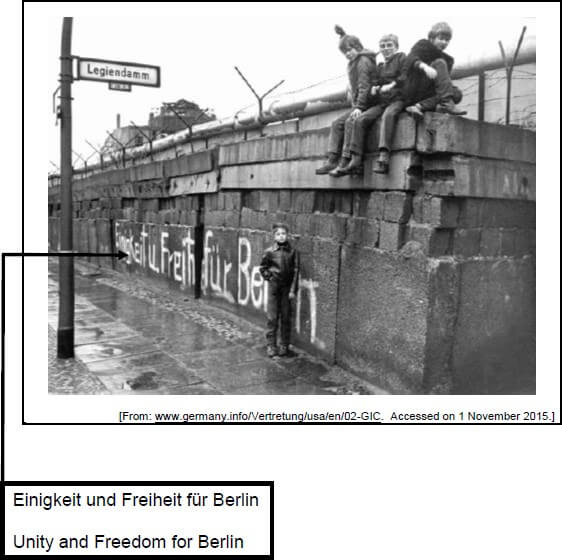
SOURCE 1D
This is an extract from a speech by President Kennedy of the United States of America. He responded to the building of the Berlin Wall in 1961 at the Rudolph Wilde Platz in Berlin.
… We cannot and will not permit the Communists to drive us out of Berlin, either gradually or by force. For the fulfilment of our pledge to that city is essential to the morale and security of Western Germany, to the unity of Western Europe, and to the faith of the entire Free World. [From: www.history.com/topics/berlin-wall. Accessed on 30 October 2015.] |
QUESTION 2: WHAT IMPACT DID THE INVOLVEMENT OF FOREIGN POWERS HAVE ON THE ANGOLAN CIVIL WAR?
SOURCE 2A
This source outlines the involvement of foreign countries in the Angolan conflict.
| The South African invasion, Cuban intervention and Soviet and American assistance internationalised the Angolan conflict. Although the FNLA ceased to exist in 1976, UNITA – benefiting from the extensive South African military assistance as well as United States aid and a lucrative (profitable) diamond smuggling industry – built a formidable fighting force of around 40 000 soldiers. For nearly two decades a civil war raged between UNITA guerrillas and the MPLA government, killing more than 1,1 million civilians, mostly in the rural areas, where over eighty percent of the population lives. The MPLA, a Marxist-Leninist party since 1977, expanded educational opportunities and the health care system and nationalised industries deserted by Portuguese settlers and foreign corporations. But its state owned farms and inefficient bureaucracies (administrative staff) only made life more difficult in the countryside, where roads deteriorated and small farmers were left without access to markets or agricultural inputs … President Neto and Jose Eduardo dos Santos, who succeeded Neto in 1979, pursued pragmatic economic policies, permitting private ownership and co-operating with Western oil companies in exploiting Angola’s rich oil reserves off the coast of the Cabinda enclave (an area totally surrounded by the territory of another country)… Much – if not all – of the $400 million annual oil revenues were spent on the war effort … [From: Africana: The Encyclopaedia of the African and African American Experience, edited by KA Appiah and HL Gates Jr.] |
SOURCE 2B
The extract below explains the reasons for the involvement of the United States of America in the Angolan conflict. It focuses on the USA’s attempts to recover from the embarrassment of Vietnam.
The USA wanted to prevent a Soviet backed communist government from coming to power in Angola. For this reason, it supplied weapons, funding and supplies both the FNLA and UNITA. This was stepped up after the American withdrawal from Vietnam. The American government was keen to assert its position in Africa after its humiliating defeat by the communists in Vietnam. They saw this as a way of restoring the balance of power between the superpowers. However, after its defeat in Vietnam, the USA was not prepared to become directly involved in the fighting by sending troops. They secretly encouraged the invasion by the South African Army, hoping that this would prevent the MPLA from coming to power. The effect of US involvement was to prolong the civil war. [From: In Search of History by J Bottaro et al] |
SOURCE 2C
This source compares two schools of thought, a Cuban and South African viewpoint on the Battle of Cuito Cuanavale.
| One school of thought (supported by the ANC, Cuba, other liberation movements and several historians) is that South Africa’s decision to launch the attack was influenced by their intention to rescue UNITA and their want to seize the town of Cuito Cuanavale through the capture of the air force base. It is argued that the actions of the SADF prior to the 23 March 1988 are clear evidence of their determination to break-through to the town. The SADF forces attacked Cuito with the massive 155 mm G-5 guns and staged attack after attack led by the crack 61st mechanised battalion, 32 Buffalo battalion, and later 4th SA Infantry group. On the 23rd March the battle reached a halt. In the words of 32 Battalion commander, Colonel Jan Breytenbach. He writes: ‘the UNITA soldiers did a lot of dying that day’ and ‘the full weight of FAPLA’s defensive fire was brought down on the heads of [SADF] Regiment President Steyn and the already bleeding UNITA.’ According to this view, the SADF failed in its intention and was successfully thwarted by the combined Angolan forces. The second school of thought maintains that the SADF had only limited objectives, namely, to halt the enemy at Cuito, to prevent its airstrip from being used, and then to retreat. Further action would have undermined negotiations between Cuba, Angola and South Africa, which began in London early in 1988 and continued in May in Brazzaville, Congo, and Cairo, Egypt. By this time, the South African government had already recognised the political change in Russia and the ending of the cold war. Gen. Jannie Geldenhuys, Chief of the SADF, stated that the most important battle in the campaign was when the Cubans were defeated at the Lomba River and Cuito Cuanavale was simply part of a mopping up operation after this battle. Following this the SADF’s intention was to prevent the capture of Mavinga and through that prevent assaults on Jamba. This was successfully accomplished. This view is supported by the SADF and several historians such as Fred Bridgeland, W.M. James and others. In addition both SADF and military analyst’s statistics are mentioned contradicting claims of a victory. Gen. Jannie Geldenhuys, Chief of the SADF, quoted the following in support of this argument: CUBA/FAPLA Tanks destroyed: 94, SADF tanks destroyed: 3, Cuban troop carriers destroyed: 100, SADF troop carriers destroyed: 5 logistical vehicles destroyed: 389 for Cuba and 1 for SADF. [From:www.sahistory.org.za/tops/battle-cuito-cuanavale. Accessed on 26 October 2015.] |
SOURCE 2D
This photograph shows the South African Defence Force recruits making their weapons safe before entering the base at Ruacana in 1988 during the Battle of Cuito Cuanavale. It is adapted from a newspaper article, The Mother of Liberation Battles.
[Source: The Mother of Liberation Battles’, an article by Ronnie Kasrils, From: Sunday Independent, 24 March 2013] |
QUESTION 3: HOW SUCCESSFUL WAS THE DESEGREGATION OF CENTRAL HIGH SCHOOL IN LITTLE ROCK, ARKANSAS, IN 1957?
SOURCE 3A
The source below is an extract taken from notes by President Dwight Eisenhower on 8 October 1957 after his meeting with Governor Faubus. It focuses on the visit of Governor Faubus of Arkansas to Little Rock on 14 September 1957. The meeting took place in Newport.
| Governor Faubus protested again and again that he was a law abiding citizen, that he was a veteran, fought in the war, and that everybody recognises that the Federal law is supreme to State law. So I suggested to him that he go home and not necessarily withdraw the National Guard troops, but just change their orders to say that having been assured that there was no attempt to do anything except to obey the Courts and that the Federal government was not trying to do anything that had not been already agreed to by the School Board and directed by the Courts; that he should tell the Guard to continue to preserve order but to allow the Negro children to attend Central High School. I pointed out at that time he was due to appear the following Friday, the 20th, before the Court to determine whether an injunction (compelling court order) was to be issued … I further said that I did not believe it was to anybody to have a trial of strength between the President and a Governor because in any area where the Federal government had assumed jurisdiction (authority) and this was upheld by the Supreme Court, there could be only one outcome … that is, the State would lose, and I did not want to see any Governor humiliated. [From: www.mhunt.weebly.com. Accessed on 13 November 2015.] |
SOURCE 3B
This is a statement by the Governor of Arkansas, Orval Faubus, after his meeting with President Dwight Eisenhower in September 1957. It outlines the incident at Central High School in Little Rock, Arkansas.
| … I have assured the President on my desire to cooperate with him in carrying out the duties resting upon both of us under the Federal Constitution. In addition, I must harmonise (bring in line with) my actions under the Constitution of Arkansas with the requirements of the Constitution of the United States. I have never expressed any personal opinion regarding the Supreme Court decision of 1954 [Brown v Board of Education] which ordered integration. This is not relevant. That decision is the law of the land and must be obeyed. At the same time it is evident from the language of the decision itself that changes necessitated by the Court orders cannot be accomplished overnight. The people of Little Rock are law-abiding and I know that they expect to obey valid court orders. In this they shall have my support. [From: www.ourdocuments.gov. Accessed on 14 November 2015.] |
SOURCE 3C
This extract describes the hardships that the African American students, who attended the ‘all-white’ Central High School. It also focuses on how their families were harassed.
Although some of the students, teachers and administration attempted to maintain a sense of normality, for the nine students that integrated Central High School it was like going to war every day. One of the Little Rock Nine, Melba Pattilo Beals, describes their experience in her book, Warriors Don’t Cry: ‘My eight friends and I paid for the integration of Central High with our innocence. During those years when we desperately needed approval from our peers, we were victims of the harshest rejection imaginable. The physical and psychological punishment we endured profoundly affected our lives. It transformed us into warriors who dared not cry even when we suffered intolerable pain.’ [From: www.nps.gov/history/nr/twhp/wwwlps/lessons . Accessed on 14 November 2015.] |
SOURCE 3D
This photograph shows some African and White American students interacting at Central High School in 1957. 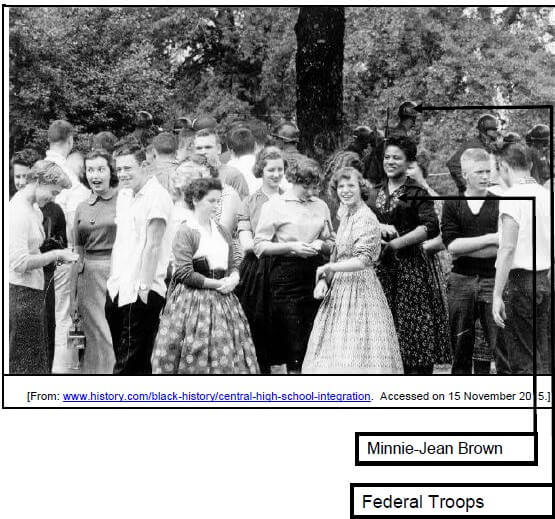
ACKNOWLEDGEMENTS
Visual sources and other historical evidence were taken from the following:
- Appiah, KA and Gates, HL Jr (Editors), Africana: The Encyclopaedia of African and African American Experience (Oxford University Press)
- Bottaro J et al, 2013, In Search of History (Oxford University Press)
- Kasrils R, “The Mother of Liberation Battles”Sunday Independent, March 24, 2013 www.berlin.de/mauer/geschichte/index.en.htm
- www.germany.info/Vertretung/usa/en/02-GIC
- www.germany.infor/Vertreting/usa/en/02-GIC
- www.history.com/black-history/central-high-school-integration
- www.history.com/topics/cold-war/berlin-wall
- www.sahistory.org.za/tops/battle-cuito-cuanavale
- www.mhunt.weebly.com
- www.nps.gov/history/nr/twhp/wwwlps/lessons
- www.ourdocuments.gov
HISTORY PAPER 2 GRADE 12 ADDENDUM - NSC PAST PAPERS AND MEMOS SEPTEMBER 2016
HISTORY
PAPER TWO (P2)
GRADE 12
NSC PAST PAPERS AND MEMOS
SEPTEMBER 2016
ADDENDUM
QUESTION 1: WHAT IMPACT DID THE PHILOSOPHY OF BLACK CONSCIOUSNESS (BC) HAVE ON SOUTH AFRICAN STUDENTS IN THE 1970s?
SOURCE 1A
This extract focuses on the influence that the philosophy of Black Consciousness have on the Soweto Uprising of 1976. It was written in 1978 by John Kane-Berman, who was a member of the SRC at the University of the Witwatersrand.
One of the principal factors explaining the new mood of assertiveness (self-confidence) so evident among black youth in many parts of the country is the growth of the Black Consciousness philosophy. This is one of the most important developments in South Africa in recent years… At about the same time, black students, after much soul searching, broke away from the multi-racial but white-dominated National Union of South African Students (NUSAS) to form the South African Students’ Organisation (SASO). After that, numerous organisations espousing (standing for) Black Consciousness were formed, including the South African Students’ Movement (SASM) among schoolchildren and the Black People’s Convention (BPC), a political organisation, of which Steve Biko was honorary president at the time of his death ... [From: SOWETO Black Revolt, White Reaction by J Kane-Berman] |
SOURCE 1B
The following is an extract of Steve Biko’s comments on the role the philosophy of Black Consciousness played in the Soweto uprising.
Where is the evidence of support among the younger generation for Black Consciousness? In one word: Soweto! The boldness, dedication, sense of purpose, and clarity of analysis of the situation – all of these things are definitely a result of Black Consciousness ideas among the young generation in Soweto and elsewhere. But this cannot be measured. For the power of a movement lies in the fact that it can indeed change the habits of people. This change is not the result of force but of dedication, of moral persuasion. This is what has got through to the young people. They realise we are not dealing with mere bread-and-butter issues. [From: Steve Biko Speaks for Himself in News and Letters, November 1977] |
SOURCE 1C
This photograph shows students marching in Soweto on 16 June 1976.
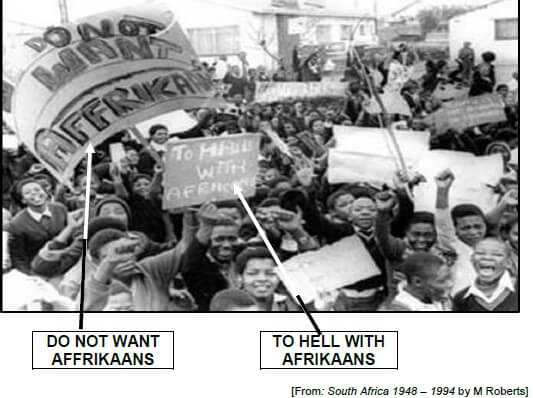 |
SOURCE 1D
This is an excerpt from an address by President Nelson Mandela at the commemoration of the twentieth anniversary of Steve Biko’s death in East London on 12 September 1997.
We are gathered here to pay homage to one of the greatest sons of our nation, Stephen Bantu Biko. His hope in life, and his life of hope, are captured by his resounding words, ‘In time, we shall be in a position to bestow on South Africa the greatest possible gift – a more humane face.’ [From: www.anc.org.za/show.phd?id=3148. Accessed on 25 April 2016.] |
QUESTION 2: HOW DID THE TRUTH AND RECONCILIATION COMMISSION (TRC) DEAL WITH THE PAST?
SOURCE 2A
This source is taken from an address by the former President of South Africa, Thabo Mbeki. It was held on the 10th Anniversary of the TRC at Freedom Park, Tshwane.
In our country, this difficult task, to reconcile discordant elements and make them cling together in our society, fall on the shoulders of the TRC.
[From: www.dfa.gov.za/docs/speeches/2005/mbeki1216.htm. Accessed on 27 April 2016.] |
SOURCE 2B
This photograph depicts Joyce Mtimkulu, the mother of Siphiwo Mtimkulu. She kept a piece of Siphiwo’s hair for more than 20 years.
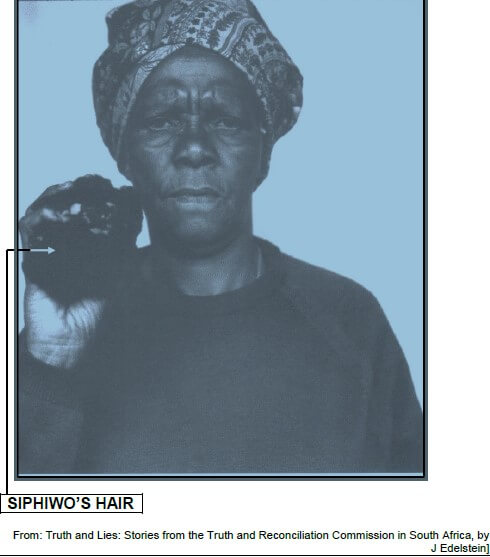 |
SOURCE 2C
The following is an extract from a newspaper article from the Daily Despatch (a newspaper in the East Cape known for its anti-apartheid views). It was written at the time of amnesty hearings of the security policemen implicated in Siphiwo’s murder.
|
SOURCE 2D
In Graeme Simpson’s article, Tell No Lies, Claim No Easy Victories: A brief evaluation of South Africa’s Truth and Reconciliation Commission, he speaks about two people who testified before the TRC.
Mrs Mlangeni – the mother of the Bheki Mlangeni [From: http://www.csvr.org.za/wits/articles/artcyal.htm. Accessed on 27 April 2016.] |
QUESTION 3: WHAT WAS THE IMPACT OF GLOBALISATION ON THE LIVES OF ORDINARY PEOPLE IN THE NEW WORLD ORDER?
SOURCE 3A
This source explains the benefits of globalisation through trade which was a way for countries to exchange goods and resources.
Globalisation can benefit all countries, rich or poor, if that country is willing to be open to international trade. Not only do they have to be open to the world market, but they would have to do it in such a strategic way based on how their country is run in order to gain from trade. Practising globalisation the exact same way, by a set of regulations may lead to a country’s economic downfall. By choosing the best way to engage in international trade, a country can successfully grow economically as well as socially. By using a country’s comparative advantage, or what they can produce at a lower opportunity cost than other countries, they can get all the benefits of trade. If every country has a comparative advantage that means that everyone can gain from trade. There is remarkable evidence that globalisation is helping countries expand and achieve higher incomes or a higher GDP. Research was conducted on national incomes around the world during the 1990s and results showed that the income of rich globalised countries increased by 2% each year. The results also show that poor, more globalised countries have a higher increase in income per year than poor, less globalised countries. Actually according to this research the poor, more globalised countries had an increase in income of 5% each year while the poor, less globalised countries had a decrease of 1% per year. On the other hand, it is suggested that there is a big gap between the rich and the poor. In 1960 the average income of the richest 20 countries was 15 times higher than the poorest 20 countries. Today the income of the richest 20 countries is 30 times higher. [From: http://www.edu-mthong/benefits of globalisation.htm#. Accessed on 27 April 2016.] |
SOURCE 3B
This photograph shows a demonstration held in November 2006 against the IMF and the World Bank.
From: http://1123.photobucket.com/albums/o319/vegan0wer/S2010133.ipg&ipg&imgrefurl=http:news.inf oshop.org/article.php. |
SOURCE 3C
The source outlines the impact of globalisation of countries around the world. It explains the relationship between the IMF, World Bank and the WTO, and how they affect the economies of the countries around the world.
The IMF, World Bank, and WTO work together in an iron triangle to carry out the corporate plan of privatisation, deregulation (removal of control), and ‘free’ trade. Although the World Bank and IMF were originally founded to be part of the United Nations, they have always been controlled by bankers and economists from the United States and Europe. [From: History for all, Grade 12, by E Brink, M Malinga et al] |
SOURCE 3D
This source highlights the living conditions in Mumbai, India. It was published in July, 2011.
[From: www.poverties.org/poverty-in India.html. Accessed on 27 April 2016] |
ACKOWLEDGEMENTS
- Brink, E et al 2012 Solutions for all History Grade 12 Macmillan SA
- Daily Dispatch 25 September 1995
- Dlamini N et al 2007 Shuter’s History. Shuter & Shooter Publishers LTD
- Edelstein, J 2005 Truth and Lies: Stories from the Truth and Reconciliation Commission in South Africa
- http://1123.photobucket.com/albums/o319/vegan0wer/S2010133.ipg&ipg&imgrefurl
- http://www.csvr.org.za/wits/articles/artcyal.htm
- http://www.edu-mthong/benefitsofglobalisation.htm#The Benefits of Globalisation
- http://www.toonpool.com/cartoons/Globalisation_30593#img9
- http://yaleglobal.yale.edu/content/globalization-you-cant-stop-life
- Kane-Berman, 1978.Soweto Black Revolt, White Reaction
- Steve Biko Memorial Lectures 2000-2008. 2009,Macmillan SA
- www.anc.org.za/show.phd?id=3148
- www.dfa.gov.za/docs/speeches/2005/mbeki1216.htm
- www.poverties.org/poverty-in India.html
HISTORY PAPER 2 GRADE 12 QUESTIONS - NSC PAST PAPERS AND MEMOS SEPTEMBER 2016
HISTORY
PAPER TWO (P2)
GRADE 12
NSC PAST PAPERS AND MEMOS
SEPTEMBER 2016
INSTRUCTIONS AND INFORMATION TO CANDIDATES
- The question paper consist of SECTION A and SECTION B based on prescribed content framework in the CAPS document:
SECTION A: SOURCE-BASED QUESTIONS
QUESTION 1: CIVIL RESISTANCE, 1970s TO 1980s: SOUTH AFRICA
QUESTION 2: THE COMING OF DEMOCRACY TO SOUTH AFRICA AND COMING TO TERMS WITH THE PAST
QUESTION 3: THE END OF THE COLD WAR AND A NEW WORLD ORDER, 1989 TO THE PRESENT
SECTION B: ESSAY QUESTIONS
QUESTION 4: CIVIL RESISTANCE, 1970s TO 1980s: SOUTH AFRICA: THE CRISIS OF APARTHEID IN THE 1980s
QUESTION 5: THE COMING OF DEMOCRACY TO SOUTH AFRICA AND COMING TO TERMS WITH THE PAST
QUESTION 6: THE END OF THE COLD WAR AND A NEW WORLD ORDER: THE EVENTS OF 1989 - SECTION A consists of THREE source-based questions. Source material that is required to answer these questions can be found in the ADDENDUM.
- SECTION B consists of THREE essay questions.
- Answer THREE questions as follows:
4.1 At least ONE must be a source-based question and at least one must be an ESSAY question.
4.2 The THIRD question can be either a source-based or an essay question. - You are advised to spend at least ONE hour per question.
- Candidates should apply their knowledge, skills and insight.
- Number the answers correctly according to the numbering system used in this question paper.
- A mere rewriting of the sources as answers will disadvantage candidates.
- Write neatly and legibly.
QUESTIONS
SECTION A: SOURCE-BASED QUESTIONS
Answer at least ONE question, but not more than TWO questions, in this section. Source material that is required to answer these questions can be found in the ADDENDUM.
QUESTION 1: WHAT IMPACT DID THE PHILOSOPHY OF BLACK CONSCIOUSNESS (BC) HAVE ON SOUTH AFRICAN STUDENTS IN THE 1970s?
Study Sources 1A, 1B, 1C and 1D to answer the following questions.
1.1 Refer to Source 1A.
1.1.1 Define the term Black Consciousness in your own words. (1 x 2) (2)
1.1.2 According to the source, list TWO organisations that promoted the philosophy of Black Consciousness among black South African students. (2 x 1) (2)
1.1.3 Why do you think more than 100 to 180 pupils boycotted an examination on a book called Swart Pelgrim by FA Venter? (1 x 2) (2)
1.1.4 Using the information in the source as well as your own knowledge, explain how the philosophy of Black Consciousness influenced African and Coloured school children in the Cape in 1976. (2 x 2) (4)
1.1.5 Explain the usefulness of this source to a historian studying the impact of SASM on African and Coloured students in the Cape in 1976. (2 x 2) (4)
1.2 Study Source 1B.
1.2.1 Quote FOUR pieces of evidence from the source that indicate that the youth of Soweto was influenced by the ideas of Black Consciousness. (4 x 1) (4)
1.2.2 Use the source and your own knowledge to explain the bread and butter issues that faced the people of Soweto. (2 x 2) (4)
1.3 Consult Source 1C.
1.3.1 According to the visual source, why did the students of Soweto embark on the protest action? (1 x 2) (2)
1.3.2 What, do you think, was the intention of the photographer in publishing this photo? (1 x 2) (2)
1.3.3 Explain the reliability of this photograph to historians studying the causes of the Soweto Uprising. (2 x 2 ) (4)
1.4 Read Source 1D.
1.4.1 Using the information in the source and your own knowledge, explain what Biko implied by wanting to give South Africa a ‘more humane face’. (2 x 2) (4)
1.4.2 Explain why the apartheid government attempted to prevent Biko’s influence as a political leader. (2 x 2) (4)
1.4.3 What was Biko’s greatest legacy that he waged during the struggle? (1 x 2) (2)
1.4.4 According to the source, what did the government do to honour Biko’s life? (2 x 1) (2)
1.5 Using the information in the relevant sources and your own knowledge, write a paragraph of about EIGHT lines (80 words) to explain the impact that the philosophy of Black Consciousness had on South African students in the 1970s. (8)
[50]
QUESTION 2: HOW DID THE TRUTH AND RECONCILIATION COMMISSION (TRC) DEAL WITH THE PAST?
Study Sources 2A, 2B, 2C and 2D to answer the following questions.
2.1 Refer to Source 2A.
2.1.1 Quote TWO difficulties that the TRC had to go through during the hearings. (2 x 1) (2)
2.1.2 Why, according to the source, were the perpetrators willing to ask for forgiveness? (1 x 1) (1)
2.1.3 Using your own knowledge, comment on the relevance of the statement ‘our people are well endowed with the spirit of Ubuntu’. (2 x 2) (4)
2.1.4 What do you understand by the concept ‘reparations’ in the context of the TRC? (1 x 2) (2)
2.2 Consult Source 2B.
2.2.1 Use the source and your own knowledge to explain why Mrs Mtimkulu appeared before the TRC. (2 x 2) (4)
2.2.2 Why, do you think, Mrs Mtimkulu kept the human hair for 20 years? (1 x 2) (2)
2.3 Read Source 2C.
2.3.1 According to the source, how did Siphiwo Mtimkulu die? (1 x 1) (1)
2.3.2 Identify the TWO security policemen involved in the killings of Siphiwo Mtimkulu. (2 x 1) (2)
2.3.3 Explain why you think Gen. Van Rensburg blatantly lied to the Harms Commission. (2 x 2) (4)
2.3.4 Identify evidence in the source to show that the apartheid government killed Mr Mtimkulu. (1 x 2) (2)
2.3.5 Using the source and your own knowledge, explain what is meant by the statement ‘her hair turned snow white since her last appearance’. (2 x 2) (4)
2.4 How does Source 2A support Source 2C with regard to the aims of the TRC? (2 x 2) (4)
2.5 Study Source 2D.
2.5.1 Indicate the way in which Bheki Mlangeni was killed. (1 x 2) (2)
2.5.2 According to the source, what is meant by Mrs Mlangeni’s statement ‘… as we are dead now’? (1 x 2) (2)
2.5.3 Quote evidence from the source that suggest that Mr Sithole expected some sort of compensation from the ANC government. (1 x 2) (2)
2.5.4 Explain the usefulness of this source to a historian studying the TRC. (2 x 2) (4)
2.6 Using the information in the relevant sources and your own knowledge, write a paragraph of about EIGHT lines (80 words) explaining how the Truth and Reconciliation Commission (TRC) was able to deal with the past. (8)
[50]
QUESTION 3: WHAT WAS THE IMPACT OF GLOBALISATION ON THE LIVES OF ORDINARY PEOPLE IN THE NEW WORLD ORDER?
Study Sources 3A, 3B, 3C and 3D to answer the following questions.
3.1 Read Source 3A.
3.1.1 Define the concept globalisation in your own words. (1 x 2) (2)
3.1.2 Identify any THREE benefits of globalisation as defined by international trade. (3 x 1) (3)
3.1.3 Use the information from the source and your own knowledge to explain the usefulness of this source to a historian studying international trade. (2 x 2) (4)
3.1.4 According to the source, explain why ‘there is big gap between the rich and poor’. (2 x 2) (4)
3.2 Consult Source 3B.
3.2.1 Use the source and your own knowledge to explain the role the IMF and World Bank played in the context of globalisation. (2 x 2) (4)
3.2.2 Explain what is implied by the slogan on the poster
‘GO TO HELL WITH YOUR AID’. (2 x 2) (4)
3.3 Study Source 3C.
3.3.1 List the THREE organisations that work together in an iron triangle plan to carry out the corporate plan of free trade. (3 x 1) (3)
3.3.2 What, according to the source was the work of the iron triangle? (2 x 1) (2)
3.3.3 Explain how the poor countries were forced to pay off their loans to the IMF and WTO. (2 x 2) (4)
3.3.4 What conclusion can you draw from the countries paying more attention to exporting food than growing food for local consumption? (1 x 2) (2)
3.3.5 According to the source, why was protection sacrificed for the indigenous people, workers and environment? (1 x 2) (2)
3.4 Use Source 3D.
3.4.1 According to the source, identify TWO negative results of globalisation. Use the visual clues from the source to support your answer. (2 x 1) (2)
3.4.2 Why, do you think, globalisation has brought poverty and inequality to poor countries? (1 x 2) (2)
3.5 Refer to Sources 3C and 3D. Comment on how these sources support each other regarding the impact of globalisation on ordinary people. (2 x 2) (4)
3.6 Using the information in the relevant sources and your own knowledge, write a paragraph of about EIGHT lines (80 words) in which you discuss the impact of globalisation on the lives of ordinary people in the New World Order. (8)
[50]
SECTION B: ESSAY QUESTIONS
Answer at least ONE question, but not more than TWO questions in this section.
Your essay should be at least THREE pages in length.
QUESTION 4: CIVIL RESISTANCE, 1970s TO 1980s: SOUTH AFRICA: THE CRISIS OF APARTHEID IN THE 1980s
In 1980, PW Botha stated, ‘the strategic position of South Africa has changed with regard to apartheid. We must adapt or die.’
Explain to what extent Botha’s adaptation of the apartheid policy was challenged by the internal resistance movements in the 1980s.
[50]
QUESTION 5: THE COMING OF DEMOCRACY TO SOUTH AFRICA AND COMING TO TERMS WITH THE PAST
‘Together the various stakeholders played a significant role in ensuring that South Africa became a non-racial democratic country in 1994.’
Do you agree with the statement? Use relevant evidence to support your line of argument.
[50]
QUESTION 6: THE END OF THE COLD WAR AND A NEW WORLD ORDER: THE EVENTS OF 1989
‘The collapse of the USSR affected South Africa’s future positively.’
Critically evaluate the statement by using relevant historical evidence to support your line of argument.
[50]
TOTAL: 150
HISTORY PAPER 1 GRADE 12 QUESTIONS - NSC PAST PAPERS AND MEMOS SEPTEMBER 2016
HISTORY
PAPER ONE (P1)
GRADE 12
NSC PAST PAPERS AND MEMOS
SEPTEMBER 2016
INSTRUCTIONS AND INFORMATION
- This question paper consists of SECTION A and SECTION B based on the prescribed content framework in the CAPS document.
SECTION A: SOURCE-BASED QUESTIONS
QUESTION 1: THE COLD WAR: THE ORIGINS OF THE COLD WAR
QUESTION 2: INDEPENDENT AFRICA: CASE STUDY – ANGOLA
QUESTION 3: CIVIL SOCIETY PROTESTS FROM THE 1950s TO THE 1970s – CIVIL RIGHTS MOVEMENT
SECTION B: ESSAY QUESTIONS
QUESTION 4: EXTENSION OF THE COLD WAR: CASE STUDY – VIETNAM
QUESTION 5: INDEPENDENT AFRICA: COMPARATIVE CASE STUDY – THE CONGO AND TANZANIA
QUESTION 6: CIVIL SOCIETY PROTESTS FROM THE 1950s TO THE 1970s: THE BLACK POWER MOVEMENT
- SECTION A consists of THREE source-based questions. Source material that is required to answer these questions will be found in the ADDENDUM.
- SECTION B consists of THREE essay questions.
- Answer THREE questions as follows:
4.1 At least ONE (1) must be a source-based question and at least ONE (1) must be an essay question.
4.2 The THIRD question can either be a source-based question or an essay question.
- Candidates are advised to spend about an hour on each question.
- When candidates answer questions, they are required to demonstrate application of knowledge, skills and insight.
- Merely rewriting of the sources as answers will be to the disadvantage of candidates.
- Questions and subsections of questions must be numbered clearly and correctly using the same numbering system used in the question paper.
- Write neatly and legibly.
QUESTIONS
SECTION A: SOURCE-BASED QUESTIONS
Answer at least ONE question, but not more than TWO questions from this section. Source material to be used to answer these questions is contained in the ADDENDUM.
QUESTION 1: HOW DID THE BERLIN CRISIS INTENSIFY THE COLD WAR TENSIONS BETWEEN THE UNITED STATES OF AMERICA AND THE SOVIET UNION IN THE 1960s?
Study Sources 1A, 1B, 1C and 1D and answer the questions that follow.
1.1 Study Source 1A.
1.1.1 Define the concept capitalism in your own words. (1 x 2) (2)
1.1.2 What, according to the source, was the main aim of the Soviet Union in West Berlin? (1 x 2) (2)
1.1.3 Quote evidence from the source which indicate how the Western powers responded to the Berlin Blockade. (1 x 2) (2)
1.1.4 Using the source and your own knowledge, explain why the Soviet Union was forced to call off the Berlin Blockade in 1949. (2 x 2) (4)
1.1.5 Explain why you think the loss of skilled personnel to West Berlin was such a serious risk for East Berlin and East Germany (GDR). (2 x 2) (4)
1.2 Refer to Source 1B.
1.2.1 Mention THREE activities from the source to prove that the actual construction of the Berlin Wall did take place. (3 x 1) (3)
1.2.2 Explain in what ways the American and Soviet tanks that confronted each other at the Friedrichstrasse border crossing proved a risk to the Cold War. (2 x 2) (4)
1.2.3 How, according to the source, was the possible confrontation between the United States of America and Soviet forces avoided? (1 x 2) (2)
1.3 How does the evidence in Source 1B support Source 1A regarding the Soviet Union’s desire to control West Berlin? (2 x 2) (4)
1.4 Use Source 1C.
1.4.1 Explain what you think was implied by the words: ‘Unity and Freedom for Berlin’ in the context of the Cold War. (2 x 2) (4)
1.4.2 Using visual clues in the photograph, explain how the Berlin Wall influenced the lives of ordinary citizens in Berlin. (2 x 2) (4)
1.5 Consult Source 1D.
1.5.1 According to President Kennedy, mention THREE reasons why it was necessary for the USA to support Berlin. (3 x 1) (3)
1.5.2 Explain whether the information in this source would be useful to a historian in understanding Kennedy’s commitment to prevent a communist takeover of Berlin. (2 x 2) (4)
1.6 Using the information in the relevant sources and your own knowledge, write a paragraph of about EIGHT lines (about 80 words) explaining how the Berlin Crisis intensified Cold War tensions between the United States of America and the Soviet Union in the 1960s. (8)
[50]
QUESTION 2: WHAT IMPACT DID THE INVOLVEMENT OF FOREIGN POWERS HAVE ON THE ANGOLAN CIVIL WAR?
Study Sources 2A, 2B, 2C and 2D and answer the questions that follow.
2.1 Refer to Source 2A.
2.1.1 Mention TWO foreign countries from the source that were involved in the Angolan conflict. (2 x 1) (2)
2.1.2 Why, according to the source, did UNITA suddenly become a strong fighting force? (1 x 2) (2)
2.1.3 Define the concept nationalisation in your own words. (1 x 2) (2)
2.1.4 Why, in your opinion, did Neto and Dos Santos allow private ownership and co-operation with Western companies? (2 x 2) (4)
2.1.5 Comment on whether the evidence in the source would be useful to a historian in understanding the reasons why the conflict in Angola started. (2 x 2) (4)
2.2 Study Source 2B.
2.2.1 Give THREE reasons from the source for the USA’s involvement in the Angolan civil war. (3 x 1) (3)
2.2.2 What, according to the source, was the effect of the USA’s involvement in the Angolan civil war? (1 x 1) (1)
2.2.3 Explain why you think the USA went out of its way to prevent a communist government from coming to power in Angola. (2 x 2) (4)
2.3 Use Source 2C.
2.3.1 Give TWO reasons from the source as to why South Africa assisted UNITA during the Angolan conflict. (2 x 1) (2)
2.3.2 Quote evidence from the source which suggests that many UNITA soldiers died during the battle. (1 x 1) (1)
2.3.3 Comment on how the information contained in the two schools of thought in the source differs, regarding the outcome of the Battle of Cuito Cuanavale. (2 x 2) (4)
2.3.4 Why do you think the SADF provided statistical evidence regarding the Battle of Cuito Cuanavale? (2 x 2) (4)
2.4 Consult Source 2D.
2.4.1 Which country became independent after the SADF was defeated at the Battle of Cuito Cuanavale? (1 x 1) (1)
2.4.2 Explain why, in your opinion, the title: The Mother of Liberation Battles was suitable for this article. (2 x 2) (4)
2.4.3 Explain what messages the photograph conveys about the SADF’s participation in the Angolan war. Use the visual clues in the source and your own knowledge to support your answer. (2 x 2) (4)
2.5 Using the information in the relevant sources and your own knowledge, write a paragraph of about EIGHT lines (about 80 words) explaining the impact the involvement of foreign powers had on the Angolan civil war. (8)
[50]
QUESTION 3: HOW SUCCESSFUL WAS THE DESEGREGATION OF SCHOOLS IN LITTLE ROCK, ARKANSAS, DURING THE 1950s?
Study Sources 3A, 3B, 3C and 3D and answer the questions that follow.
3.1 Refer to Source 3A.
3.1.1 Quote THREE reasons from the source why Governor Faubus could be regarded as a good citizen. (3 x 1) (3)
3.1.2 What, according to the source, were the TWO instructions given to Faubus by President Eisenhower during their meeting? (2 x 1) (2)
3.1.3 Using the source and your own knowledge explain why there was a need for a meeting between Faubus and Eisenhower. (2 x 2) (4)
3.1.4 Why, according to the source, did Eisenhower try to discourage Faubus from taking the Little Rock Nine issue to court? (1 x 2) (2)
3.1.5 Comment on whether Eisenhower was justified in instructing Faubus to change the orders that he gave to the National Guard, regarding the events at Central High School. (2 x 2) (4)
3.2 Read Source 3B.
3.2.1 Define the concept integration, in the context of the Little Rock Nine incident. (1 x 2) (2)
3.2.2 In the source Faubus states, ‘That decision is the law of the land and must be obeyed.’ Explain whether you would regard this statement to be in line with the Little Rock Nine incident. (2 x 2) (4)
3.2.3 Using the source and your own knowledge, explain the messages that Faubus is trying to communicate to the public. (2 x 2) (4)
3.3 Explain how the information in Source 3B and Source 3A differs regarding the commitments that Faubus made to President Eisenhower. (2 x 2) (4)
3.4 Use Source 3C.
3.4.1 Explain what was implied by the statement: “It was like going to war every day”. (2 x 2) (4)
3.4.2 Mention THREE ways in which African American students were treated at the school. (3 x 1) (3)
3.4.3 The reaction of conservative white Americans had a negative effect on the African American community of Little Rock. Quote TWO pieces of evidence from the source to support this statement. (2 x 1) (2)
3.5 Consider Source 3D.
3.5.1 Use a visual clue in the source to explain that integration took place at Central High School. (1 x 2) (2)
3.5.2 What does the presence of uniformed personnel in the source, suggest about the situation at Central High School? (1 x 2) (2)
3.6 Using the information in the relevant sources and your own knowledge, write a paragraph of about EIGHT lines (about 80 words) explaining the success of the desegregation of schools in Little Rock, Arkansas, during the 1950s. (8)
[50]
SECTION B: ESSAY QUESTIONS
Answer at least ONE question, but not more than TWO questions from this section.
QUESTION 4: EXTENSION OF THE COLD WAR: CASE STUDY – VIETNAM
The United States of America was successful in preventing the communist takeover of Vietnam between 1962 and 1974.
Do you agree with the above statement? Support your answer with reference to the United States of America’s involvement in the war.
[50]
QUESTION 5: INDEPENDENT AFRICA: COMPARATIVE CASE STUDY – THE CONGO AND TANZANIA
Evaluate the successes of Tanzania’s and the Congo’s economic development programmes after independence.
[50]
QUESTION 6: CIVIL SOCIETY PROTESTS IN THE 1950s TO THE 1960s: THE BLACK POWER MOVEMENT
The relatively slow pace of success and the philosophy of non-violence did not find universal support among the young and militant sections of the African American community.
Critically discuss this statement with reference to how the emergence of the Black Power Movement, presented an alternative to the philosophy of the Civil Rights Movement.
[50]
TOTAL: 150
